
Tales (not just) from the high seas


Why A Ketch Is The Best Offshore Sailboat
In a cruising world dominated by catamarans and light-displacement boats the ketch rig seems almost antiquated among the YouTube generation. But if you’re serious about off-shore sailing, the ketch rig has proven its worth time and time again, even by today’s standards.
For balance, performance, handling and comfort, a ketch is difficult to beat.
Out here in the cruising world, ketches are a popular alternative to other rigs because those smaller sails are easier to manage. This makes it easier for couples, liveaboards and older sailors. For short-handed sailing across long distances while facing rough waters and heavier winds, the small sails on a ketch are easy to handle. Ketches are also a good set-up for families because you can sail a larger boat without having to handle considerably larger sails.
KETCH 101 A ketch has two masts: a traditional mainmast, just like a sloop, and a second mast at the rear of the boat, called a mizzen mast. For it to be a ketch, the mizzen is mounted forward of the rudder-post. If it’s mounted behind, it’s called a yawl.
SAILS The main sails used on a ketch are the headsail, the mainsail and the mizzen sail, so one more than a sloop. But of course any number of additional sails may be used. Esper has a stay sail, which makes her a cutter-rigged ketch. Light-wind sails may also be used.
- Yankee Starting at the head, ketches are most likely to have a yankee. This is a high-cut headsail and is normally 100% (the clew only comes back as far as the mast). The two main advantages of this are that it may be used in heavier weather without reefing, thus keeping the sail shape, and the high foot allows the seas to break without it dragging through the water.
- Staysail If the ketch is rigged with a staysail, this is mounted on the inner forestay and creates a slot between the headsail and the mainsail to provide extra lift. This is known as a cutter rig (both ketches and sloops can be cutter rigged).
- Mainsail The main mast will be shorter than a traditional sloop but it’s normally stepped in the same location, which is why boat manufacturers can offer both sail plans from the same mold.
- Mizzen The sail that makes the difference. A smaller version of the mainmast which provides a whole host of advantages (see below).
- Mizzen Staysail A light-wind sail that is taken from the top of the mizzen and down to the centre of the boat, forward of the cockpit. Paired with a cruising chute or other light-wind sails at the front of the boat, it provides extra speed and stability in light airs.
NOT ALWAYS MORE SAIL AREA Having an extra sail doesn’t always mean you have a larger sail plan. The sail plan of the boat is designed around other factors like displacement and hull shape. In most cases the individual sails of a ketch will be smaller than that of a sloop, but made up for by the additional mizzen sail.
“A mono is good if you want to head into higher latitudes. A cat is good if you like having space. We live on the edge in Wellington NZ and it’s interesting to see how few cats come south. I have a sloop, but I’d love a ketch.” -Robin Marshall, YouTube Sailing Channels Facebook group .
- Easy to manage The biggest advantage is the smaller sails, making them easier to manage especially in heavy weather.
- Single-handed Contrary to popular belief, single-handed sailing is a lot easier, especially in heavy weather because of the smaller, easier to manage sails.
- More versatile sail plans With up to four sails versus the two on a sloop, you have multiple options for managing different sailing conditions.
- Better power balance It’s not unusual to be able to quickly balance the boat and set the sails to allow the boat to sail itself without auto-pilot. Once set, it’s easy to trim the mizzen from the cockpit. The mizzen is a great way to quickly steer the boat and offers an advantage should you lose steering. The mizzen helps distribute the power throughout the boat, rather than it being at the middle and forward of the mast
- Better heavy weather performance Because the mizzen offers better control of the stern, the boat is more balanced, especially in heavy weather, and therefore a more comfortable ride.
- Easier Reefing With smaller sails, reefing down is a lot easier and can be done in any order depending upon the wind. It’s often the first sail we get out and the last to put away.
- Downwind performance The mizzen and the main work well together when running down wind. In our videos, you may have seen us pole out the yankee and mizzen only.
- Reduction in stress Basic physics will tell you that the larger the rigging and mast, the more stress you’re introducing. Shorter masts equal less stress and therefore less wear. This can translate into less wear on your rigging.
- Heaving to Heaving-to with the mizzen and staysail is easier to manage and provides great stability.
- Spare sail The mizzen ultimately provides you with a spare sail. Should you lose your main you have a ready-made contingency.
- Centre cockpit Ketches are almost always centre-cockpit, providing a smoother ride as well as added safety.
- Stability whilst anchoring and at anchor We frequently keep the mizzen up when anchoring. Leaving the mizzen out as a riding sail can help keep the boat into wind. We don’t do this often, because it means putting additional wear and tear on the sail but it has been useful.
- Crane You can use the mizzen boom as a crane. We used to keep our small dinghy on the back of the boat and the mizzen was perfect for craning out of the water. It can also be used to winch someone from the water.
“Four sails over two offer a great advantage in terms of sail plan.”
DISADVANTAGES
- Sailing to windward On paper ketch rigs generally do not sail as fast or as close to the wind as a sloop sailboat. In practice we have never had a problem going to windward, in part due to the cutter staysail, and would argue this issue is only of concern to racing sailors.
- Heavier An extra mast and rigging makes the boat heavier. Ketches will be slower than their sloop counterparts. However, you’ll be reefing later as the wind picks up so you can really ramp up a ketch rig.
- Maintenance and cost A ketch has two masts so double the rigging maintenance and replacement costs.
- Triatic If you have a triatic stay, like Esper does, this is potentially a disaster if one of the masts comes down – it’ll take the other with it.
- Space on deck One of the biggest practical disadvantages is that the mizzen mast takes up space in the stern. We know sailors who have removed the mizzen mast in order to free up space. We would never recommend this. The sail plan has been designed specifically for your boat and removing the mizzen will upset the boat’s balance. You’ll also lose out on the many advantages mentioned above.
- Older boats It’s quite rare to find new ketches under 50ft, which means affordable second-hand blue-water ketches are more likely to be older. This also makes them harder to find.
- Wind vane On paper the mizzen sail can disturb any wind vane mounted on the back of the boat. But we used our Wind Pilot extensively with the mizzen out all the way from Turkey to Malaysia.
- Shadows on Solar The mizzen boom can cast shadows on solar panels mounted at the back of the boat, reducing their efficiency.

CONCLUSION The disadvantages are minimal for the average off-shore cruiser. For us comfort is more important than that extra 0.3kn when going up wind, but that doesn’t stop us from constantly sail trimming to get the most out of Esper’s performance.
As always, thanks for supporting us and allowing us to share our adventure with you.
Peace, fair winds and stay safe
Liz, Jamie and Millie xxx
🤝 FTBMATES 🎬 SUBSCRIBE TO FTB’s SAILING CHANNEL 🛒 FTB MERCH
Please support us by clicking an icon below and sharing this post. Cheers!
If you like our content and would like to support us, we will give you ad-free access to our videos before they go live to the public, discounts in our shop, access to Jamie’s iconic full-res photographs, and supporter-only blog posts. Click our ugly mugs for more info!

9 thoughts on “Why A Ketch Is The Best Offshore Sailboat”
How did you rig your Yankee and staysail? Are they roller furling and if so how did you rig them? Did you need to add a pendant?
They are roller furling, Corey. We added a pendant to the bottom of the yankee because we were getting halyard wrap, which has solved the issue
Thanks for that excellent analysis Liz and Jamie. How do you find the mast furling mainsail and Mizzen? Does it get caught? Presumably you don’t have battens. We’re thinking of moving up in size from a sloop to a ketch. Your information was timely and helpful! Cheers Ruth and Michael
The boat came with in-mast furling, which was on Jamie’s ‘don’t want’ list (just as a ketch was)! Compromises, eh? 😉 We love the in-mast, it works and hasn’t stuck (so far) on either mast except once or twice when the halyard was set wrong in the early days. So pleased the video was of use, we stand by everything we say and if had all the money in the world would always choose a ketch. Peace and fair winds!
Interesting! Thanks for sharing!
I love the idea of the ketch for a couple to sail, especially the extra options with the mizzen. However you’re correct that around 40 ft you’re typically looking at older boats. There are 2 for sale in my neck of the woods and they’re both 40 years old. “I’m old, not obsolete”. Cheers Stuart
Too right – “Age is an issue of mind over matter. If you don’t mind, it doesn’t matter.” – Mark Twain Some of the oldest boats are double-masters, but it’s difficult to get one under 50′ these days, I agree. People are scared of them, I guess? We’ll have a word with Oyster!
Yes – and No!
(1) For those of us that cannot afford a 50 foot + ketch intrusion into the aft cabin is a major issue – given that a centre cockpit is by far the best layout for cruising. (2) Several of the advantages you sight are related to the cutter rig – which are also relevant to a cutter rigged sloop. In particular when close hauled and downwind where a simple goosewing is easy to run with. I would never rig a mizzen for running where there are gusty conditions as it will tend to slew.
Given that the wind is always on the nose, in terms of performance, cost, ease of handling and solar efficiency, it’s a centre-cockpit cutter-rigged sloop every time!
Kindest regards from sunny (and virus-free) N Cyprus.
Yes, we’d never have any kind of boat without a cutter rig, it’s brilliant anywhere let alone for long passages. We love our cutter-rig ketch, the mizzen is the first sail out and the last to go away. We often use the mizzen without the main and to be honest, I can’t imagine sailing without one these days. I think a centre-cockpit, cutter-rigged sloop would be a close second. 😉
Leave a Comment Cancel Reply
You must be logged in to post a comment.
- Yachting World
- Digital Edition

43 of the best bluewater sailboat designs of all time
- January 5, 2022
How do you choose the right yacht for you? We highlight the very best bluewater sailboat designs for every type of cruising

Which yacht is the best for bluewater boating? This question generates even more debate among sailors than questions about what’s the coolest yacht , or the best for racing. Whereas racing designs are measured against each other, cruising sailors get very limited opportunities to experience different yachts in real oceangoing conditions, so what is the best bluewater sailboat?
Here, we bring you our top choices from decades of designs and launches. Over the years, the Yachting World team has sailed these boats, tested them or judged them for European Yacht of the Year awards, and we have sifted through the many to curate a selection that we believe should be on your wishlist.
Making the right choice may come down to how you foresee your yacht being used after it has crossed an ocean or completed a passage: will you be living at anchor or cruising along the coast? If so, your guiding requirements will be space, cabin size, ease of launching a tender and anchoring closer to shore, and whether it can comfortably accommodate non-expert-sailor guests.
Article continues below…

The perfect boat: what makes an ideal offshore cruising yacht?
Choosing a boat for offshore cruising is not a decision to be taken lightly. I have researched this topic on…

European Yacht of the Year 2019: Best luxury cruisers
Before the sea trials began, I would have put money on a Hallberg-Rassy or the Wauquiez winning an award. The…
All of these considerations have generated the inexorable rise of the bluewater catamaran – monohulls can’t easily compete on these points. We have a full separate feature on the best bluewater multihulls of all time and here we mostly focus on monohulls. The only exceptions to that rule are two multihulls which made it into our best bluewater sailboats of 2022 list.
As so much of making the right choice is selecting the right boat for the venture in mind, we have separated out our edit into categories: best for comfort; for families; for performance; and for expedition or high latitudes sailing .
Best bluewater sailboats of 2022
The new flagship Allures 51.9, for example, is a no-nonsense adventure cruising design built and finished to a high standard. It retains Allures’ niche of using aluminium hulls with glassfibre decks and superstructures, which, the yard maintains, gives the optimum combination of least maintenance and less weight higher up. Priorities for this design were a full beam aft cabin and a spacious, long cockpit. Both are excellent, with the latter, at 6m long, offering formidable social, sailing and aft deck zones.
It likes some breeze to come to life on the wheel, but I appreciate that it’s designed to take up to five tonnes payload. And I like the ease with which you can change gears using the furling headsails and the positioning of the powerful Andersen winches inboard. The arch is standard and comes with a textile sprayhood or hard bimini.
Below decks you’ll find abundant headroom and natural light, a deep U-shape galley and cavernous stowage. For those who like the layout of the Amel 50 but would prefer aluminium or shoal draught, look no further.
Allures 51.9 price: €766,000
The Ovni 370 is another cunning new aluminum centreboard offering, a true deck saloon cruiser for two. The designers say the biggest challenge was to create a Category A ocean going yacht at this size with a lifting keel, hence the hull had to be very stable.
Enjoyable to helm, it has a practical, deep cockpit behind a large sprayhood, which can link to the bimini on the arch. Many of its most appealing features lie in the bright, light, contemporary, clever, voluminous interior, which has good stowage and tankage allocation. There’s also a practical navstation, a large workroom and a vast separate shower. I particularly like the convertible saloom, which can double as a large secure daybed or pilot berth.
Potentially the least expensive Category A lift keel boat available, the Ovni will get you dreaming of remote places again.
Ovni 370 price: €282,080

There’s no shortage of spirit in the Windelo 50. We gave this a sustainability award after it’s founders spent two years researching environmentally-friendly composite materials, developing an eco-composite of basalt fibre and recycled PET foam so it could build boats that halve the environmental impact of standard glassfibre yachts.
The Windelo 50 is an intriguing package – from the styling, modular interior and novel layout to the solar field on the roof and the standard electric propulsion, it is completely fresh.
Windelo 50 price: €795,000
Best bluewater sailboat of 2022 – Outremer 55
I would argue that this is the most successful new production yacht on the market. Well over 50 have already sold (an equipped model typically costs €1.6m) – and I can understand why. After all, were money no object, I had this design earmarked as the new yacht I would most likely choose for a world trip.
Indeed 55 number one Sanya, was fully equipped for a family’s world cruise, and left during our stay for the Grand Large Odyssey tour. Whereas we sailed Magic Kili, which was tricked up with performance options, including foam-cored deckheads and supports, carbon crossbeam and bulkheads, and synthetic rigging.
At rest, these are enticing space ships. Taking one out to sea is another matter though. These are speed machines with the size, scale and loads to be rightly weary of. Last month Nikki Henderson wrote a feature for us about how to manage a new breed of performance cruising cats just like this and how she coaches new owners. I could not think of wiser money spent for those who do not have ample multihull sailing experience.
Under sail, the most fun was obviously reserved for the reaching leg under asymmetric, where we clocked between 11-16 knots in 15-16 knots wind. But it was the stability and of those sustained low teen speeds which really hit home – passagemaking where you really cover miles.
Key features include the swing helms, which give you views from outboard, over the coachroof or from a protected position in the cockpit through the coachroof windows, and the vast island in the galley, which is key to an open plan main living area. It helps provide cavernous stowage and acts as the heart of the entertaining space as it would in a modern home. As Danish judge Morten Brandt-Rasmussen comments: “Apart from being the TGV of ocean passages the boat offers the most spacious, open and best integration of the cockpit and salon areas in the market.”
Outremer has done a top job in packing in the creature comforts, stowage space and payload capacity, while keeping it light enough to eat miles. Although a lot to absorb and handle, the 55 offers a formidable blend of speed and luxury cruising.
Outremer 55 price: €1.35m
Best bluewater sailboats for comfort
This is the successor to the legendary Super Maramu, a ketch design that for several decades defined easy downwind handling and fostered a cult following for the French yard. Nearly a decade old, the Amel 55 is the bridge between those world-girdling stalwarts and Amel’s more recent and totally re-imagined sloop designs, the Amel 50 and 60.
The 55 boasts all the serious features Amel aficionados loved and valued: a skeg-hung rudder, solidly built hull, watertight bulkheads, solid guardrails and rampart bulwarks. And, most noticeable, the solid doghouse in which the helmsman sits in perfect shelter at the wheel.
This is a design to live on comfortably for long periods and the list of standard features just goes on and on: passarelle; proper sea berths with lee cloths; electric furling main and genoa; and a multitude of practical items that go right down to a dishwasher and crockery.
There’s no getting around the fact these designs do look rather dated now, and through the development of easier sail handling systems the ketch rig has fallen out of fashion, but the Amel is nothing short of a phenomenon, and if you’ve never even peeked on board one, you really have missed a treat.

Photo: Sander van der Borch
Contest 50CS
A centre cockpit cruiser with true longevity, the Contest 50CS was launched by Conyplex back in 2003 and is still being built by the family-owned Dutch company, now in updated and restyled form.
With a fully balanced rudder, large wheel and modern underwater sections, the Contest 50CS is a surprisingly good performer for a boat that has a dry weight of 17.5 tonnes. Many were fitted with in-mast furling, which clearly curtails that performance, but even without, this boat is set up for a small crew.
Electric winches and mainsheet traveller are all easy to reach from the helm. On our test of the Contest 50CS, we saw for ourselves how two people can gybe downwind under spinnaker without undue drama. Upwind, a 105% genoa is so easy to tack it flatters even the weediest crewmember.
Down below, the finish level of the joinery work is up there among the best and the interior is full of clever touches, again updated and modernised since the early models. Never the cheapest bluewater sailing yacht around, the Contest 50CS has remained in demand as a brokerage buy. She is a reassuringly sure-footed, easily handled, very well built yacht that for all those reasons has stood the test of time.
This is a yacht that would be well capable of helping you extend your cruising grounds, almost without realising it.
Read more about the Contest 50CS and the new Contest 49CS

Photo: Rick Tomlinson
Hallberg-Rassy 48 Mk II
For many, the Swedish Hallberg-Rassy yard makes the quintessential bluewater cruiser for couples. With their distinctive blue cove line, these designs are famous for their seakindly behaviour, solid-as-a-rock build and beautifully finished, traditional interiors.
To some eyes, Hallberg-Rassys aren’t quite cool enough, but it’s been company owner Magnus Rassy’s confidence in the formula and belief in incremental ‘step-by-step’ evolution that has been such an exceptional guarantor of reliable quality, reputation and resale value.
The centre cockpit Hallberg-Rassy 48 epitomises the concept of comfort at sea and, like all the Frers-designed Hallberg-Rassys since the 1990s, is surprisingly fleet upwind as well as steady downwind. The 48 is perfectly able to be handled by a couple (as we found a few years back in the Pacific), and could with no great effort crack out 200-mile days.
The Hallberg-Rassy 48 was launched nearly a decade ago, but the Mk II from 2014 is our pick, updated with a more modern profile, larger windows and hull portlights that flood the saloon and aft cabin with light. With a large chart table, secure linear galley, heaps of stowage and space for bluewater extras such as machinery and gear, this yacht pretty much ticks all the boxes.

Discovery 55
First launched in 2000, the Discovery 55 has stood the test of time. Designed by Ron Holland, it hit a sweet spot in size that appealed to couples and families with world girdling plans.
Elegantly styled and well balanced, the 55 is also a practical design, with a deep and secure cockpit, comfortable seating, a self-tacking jib, dedicated stowage for the liferaft , a decent sugar scoop transom that’s useful for swimming or dinghy access, and very comfortable accommodation below. In short, it is a design that has been well thought out by those who’ve been there, got the bruises, stubbed their toes and vowed to change things in the future if they ever got the chance.
Throughout the accommodation there are plenty of examples of good detailing, from the proliferation of handholds and grabrails, to deep sinks in the galley offering immediate stowage when under way and the stand up/sit down showers. Stowage is good, too, with plenty of sensibly sized lockers in easily accessible positions.
The Discovery 55 has practical ideas and nifty details aplenty. She’s not, and never was, a breakthrough in modern luxury cruising but she is pretty, comfortable to sail and live on, and well mannered.

Photo: Latitudes Picture Library
You can’t get much more Cornish than a Rustler. The hulls of this Stephen Jones design are hand-moulded and fitted out in Falmouth – and few are more ruggedly built than this traditional, up-for-anything offshore cruiser.
She boasts an encapsulated lead keel, eliminating keel bolts and creating a sump for generous fuel and water tankage, while a chunky skeg protects the rudder. She is designed for good directional stability and load carrying ability. These are all features that lend this yacht confidence as it shoulders aside the rough stuff.
Most of those built have had a cutter rig, a flexible arrangement that makes sense for long passages in all sea and weather conditions. Down below, the galley and saloon berths are comfortable and sensible for living in port and at sea, with joinery that Rustler’s builders are rightly proud of.
As modern yachts have got wider, higher and fatter, the Rustler 42 is an exception. This is an exceptionally well-mannered seagoing yacht in the traditional vein, with elegant lines and pleasing overhangs, yet also surprisingly powerful. And although now over 20 years old, timeless looks and qualities mean this design makes her look ever more like a perennial, a modern classic.
The definitive crossover size, the point at which a yacht can be handled by a couple but is just large enough to have a professional skipper and be chartered, sits at around the 60ft mark. At 58ft 8in, the Oyster 575 fitted perfectly into this growing market when launched in 2010. It went on to be one of the most popular models from the yard, and is only now being superseded by the newer Rob Humphreys-designed Oyster 565 (just launched this spring).
Built in various configurations with either a deep keel, shoal draught keel or centreboard with twin rudders, owners could trade off better performance against easy access to shallower coves and anchorages. The deep-bodied hull, also by Rob Humphreys, is known for its easy motion at sea.
Some of the Oyster 575’s best features include its hallmark coachroof windows style and centre cockpit – almost everyone will know at first glance this is an Oyster – and superb interior finish. If she has a flaw, it is arguably the high cockpit, but the flip side is the galley headroom and passageway berth to the large aft stateroom.
This design also has a host of practical features for long-distance cruising, such as high guardrails, dedicated liferaft stowage, a vast lazarette for swallowing sails, tender, fenders etc, and a penthouse engine room.

Privilege Serie 5
A true luxury catamaran which, fully fitted out, will top €1m, this deserves to be seen alongside the likes of the Oyster 575, Gunfleet 58 and Hallberg-Rassy 55. It boasts a large cockpit and living area, and a light and spacious saloon with an emphasis on indoor-outdoor living, masses of refrigeration and a big galley.
Standout features are finish quality and solid build in a yacht designed to take a high payload, a secure walkaround deck and all-round views from the helm station. The new Privilege 510 that will replace this launches in February 2020.
Gunfleet 43
It was with this Tony Castro design that Richard Matthews, founder of Oyster Yachts, launched a brand new rival brand in 2012, the smallest of a range stretching to the flagship Gunfleet 74. The combination of short overhangs and centre cockpit at this size do make the Gunfleet 43 look modern if a little boxy, but time and subsequent design trends have been kind to her lines, and the build quality is excellent. The saloon, galley and aft cabin space is exceptional on a yacht of this size.

Photo: David Harding
Conceived as a belt-and-braces cruiser, the Kraken 50 launched last year. Its unique points lie underwater in the guise of a full skeg-hung rudder and so-called ‘Zero Keel’, an encapsulated long keel with lead ballast.
Kraken Yachts is the brainchild of British businessman and highly experienced cruiser Dick Beaumont, who is adamant that safety should be foremost in cruising yacht design and build. “There is no such thing as ‘one yacht for all purposes’… You cannot have the best of all worlds, whatever the salesman tells you,” he says.
Read our full review of the Kraken 50 .

Wauquiez Centurion 57
Few yachts can claim to be both an exciting Med-style design and a serious and practical northern European offshore cruiser, but the Wauquiez Centurion 57 tries to blend both. She slightly misses if you judge solely by either criterion, but is pretty and practical enough to suit her purpose.
A very pleasant, well-considered yacht, she is impressively built and finished with a warm and comfortable interior. More versatile than radical, she could be used for sailing across the Atlantic in comfort and raced with equal enjoyment at Antigua Sailing Week .

A modern classic if ever there was one. A medium to heavy displacement yacht, stiff and easily capable of standing up to her canvas. Pretty, traditional lines and layout below.

Photo: Voyage of Swell
Well-proven US legacy design dating back to the mid-1960s that once conquered the Transpac Race . Still admired as pretty, with slight spoon bow and overhanging transom.

Capable medium displacement cruiser, ideal size and good accommodation for couples or family cruising, and much less costly than similar luxury brands.

Photo: Peter Szamer
Swedish-built aft cockpit cruiser, smaller than many here, but a well-built and finished, super-durable pocket ocean cruiser.

Tartan 3700
Designed as a performance cruiser there are nimbler alternatives now, but this is still an extremely pretty yacht.
Broker ’ s choice

Discovery 55 Brizo
This yacht has already circumnavigated the globe and is ‘prepared for her next adventure,’ says broker Berthon. Price: £535,000 + VAT

Oyster 575 Ayesha
‘Stunning, and perfectly equipped for bluewater cruising,’ says broker Ancasta International. Price: £845,000 (tax not paid)

Oyster 575 Pearls of Nautilus
Nearly new and with a high spec, this Oyster Brokerage yacht features American white oak joinery and white leather upholstery and has a shoal draught keel. Price: $1.49m
Best bluewater yachts for performance
The Frers-designed Swan 54 may not be the newest hull shape but heralded Swan’s latest generation of displacement bluewater cruisers when launched four years ago. With raked stem, deep V hull form, lower freeboard and slight curve to the topsides she has a more timeless aesthetic than many modern slab-sided high volume yachts, and with that a seakindly motion in waves. If you plan to cover many miles to weather, this is probably the yacht you want to be on.

Photo: Carlo Borlenghi
Besides Swan’s superlative build quality, the 54 brings many true bluewater features, including a dedicated sail locker. There’s also a cockpit locker that functions as a utility cabin, with potential to hold your generator and washing machine, or be a workshop space.
The sloping transom opens out to reveal a 2.5m bathing platform, and although the cabins are not huge there is copious stowage space. Down below the top-notch oak joinery is well thought through with deep fiddles, and there is a substantial nav station. But the Swan 54 wins for handling above all, with well laid-out sail controls that can be easily managed between a couple, while offering real sailing enjoyment to the helmsman.

Photo: Graham Snook
The Performance Cruiser winner at the 2019 European Yacht of the Year awards, the Arcona 435 is all about the sailing experience. She has genuine potential as a cruiser-racer, but her strengths are as an enjoyable cruiser rather than a full-blown liveaboard bluewater boat.
Build quality is excellent, there is the option of a carbon hull and deck, and elegant lines and a plumb bow give the Arcona 435 good looks as well as excellent performance in light airs. Besides slick sail handling systems, there are well thought-out features for cruising, such as ample built-in rope bins and an optional semi-closed stern with stowage and swim platform.

Outremer 51
If you want the space and stability of a cat but still prioritise sailing performance, Outremer has built a reputation on building catamarans with true bluewater characteristics that have cruised the planet for the past 30 years.
Lighter and slimmer-hulled than most cruising cats, the Outremer 51 is all about sailing at faster speeds, more easily. The lower volume hulls and higher bridgedeck make for a better motion in waves, while owners report that being able to maintain a decent pace even under reduced canvas makes for stress-free passages. Deep daggerboards also give good upwind performance.
With bucket seats and tiller steering options, the Outremer 51 rewards sailors who want to spend time steering, while they’re famously well set up for handling with one person on deck. The compromise comes with the interior space – even with a relatively minimalist style, there is less cabin space and stowage volume than on the bulkier cats, but the Outremer 51 still packs in plenty of practical features.

The Xc45 was the first cruising yacht X-Yachts ever built, and designed to give the same X-Yachts sailing experience for sailors who’d spent years racing 30/40-footer X- and IMX designs, but in a cruising package.
Launched over 10 years ago, the Xc45 has been revisited a few times to increase the stowage and modernise some of the styling, but the key features remain the same, including substantial tanks set low for a low centre of gravity, and X-Yachts’ trademark steel keel grid structure. She has fairly traditional styling and layout, matched with solid build quality.
A soft bilge and V-shaped hull gives a kindly motion in waves, and the cockpit is secure, if narrow by modern standards.

A three or four cabin catamaran that’s fleet of foot with high bridgedeck clearance for comfortable motion at sea. With tall daggerboards and carbon construction in some high load areas, Catana cats are light and quick to accelerate.

Sweden Yachts 45
An established bluewater design that also features in plenty of offshore races. Some examples are specced with carbon rig and retractable bowsprits. All have a self-tacking jib for ease. Expect sweeping areas of teak above decks and a traditionally wooded interior with hanging wet locker.

A vintage performer, first launched in 1981, the 51 was the first Frers-designed Swan and marked a new era of iconic cruiser-racers. Some 36 of the Swan 51 were built, many still actively racing and cruising nearly 40 years on. Classic lines and a split cockpit make this a boat for helming, not sunbathing.

Photo: Julien Girardot / EYOTY
The JPK 45 comes from a French racing stable, combining race-winning design heritage with cruising amenities. What you see is what you get – there are no superfluous headliners or floorboards, but there are plenty of ocean sailing details, like inboard winches for safe trimming. The JPK 45 also has a brilliantly designed cockpit with an optional doghouse creating all-weather shelter, twin wheels and superb clutch and rope bin arrangement.

Photo: Andreas Lindlahr
For sailors who don’t mind exchanging a few creature comforts for downwind planing performance, the Pogo 50 offers double-digit surfing speeds for exhilarating tradewind sailing. There’s an open transom, tiller steering and no backstay or runners. The Pogo 50 also has a swing keel, to nose into shallow anchorages.

Seawind 1600
Seawinds are relatively unknown in Europe, but these bluewater cats are very popular in Australia. As would be expected from a Reichel-Pugh design, this 52-footer combines striking good looks and high performance, with fine entry bows and comparatively low freeboard. Rudders are foam cored lifting designs in cassettes, which offer straightforward access in case of repairs, while daggerboards are housed under the deck.
Best bluewater sailboats for families
It’s unsurprising that, for many families, it’s a catamaran that meets their requirements best of increased space – both living space and separate cabins for privacy-seeking teenagers, additional crew or visiting family – as well as stable and predictable handling.

Photo: Nicholas Claris
Undoubtedly one of the biggest success stories has been the Lagoon 450, which, together with boats like the Fountaine Pajot 44, helped drive up the popularity of catamaran cruising by making it affordable and accessible. They have sold in huge numbers – over 1,000 Lagoon 450s have been built since its launch in 2010.
The VPLP-designed 450 was originally launched with a flybridge with a near central helming position and upper level lounging areas (450F). The later ‘sport top’ option (450S) offered a starboard helm station and lower boom (and hence lower centre of gravity for reduced pitching). The 450S also gained a hull chine to create additional volume above the waterline. The Lagoon features forward lounging and aft cockpit areas for additional outdoor living space.
Besides being a big hit among charter operators, Lagoons have proven themselves over thousands of bluewater miles – there were seven Lagoon 450s in last year’s ARC alone. In what remains a competitive sector of the market, Lagoon has recently launched a new 46, with a larger self-tacking jib and mast moved aft, and more lounging areas.

Photo: Gilles Martin-Raget
Fountaine Pajot Helia 44
The FP Helia 44 is lighter, lower volume, and has a lower freeboard than the Lagoon, weighing in at 10.8 tonnes unloaded (compared to 15 for the 450). The helm station is on a mezzanine level two steps up from the bridgedeck, with a bench seat behind. A later ‘Evolution’ version was designed for liveaboard cruisers, featuring beefed up dinghy davits and an improved saloon space.
Available in three or four cabin layouts, the Helia 44 was also popular with charter owners as well as families. The new 45 promises additional volume, and an optional hydraulically lowered ‘beach club’ swim platform.

Photo: Arnaud De Buyzer / graphikup.com
The French RM 1370 might be less well known than the big brand names, but offers something a little bit different for anyone who wants a relatively voluminous cruising yacht. Designed by Marc Lombard, and beautifully built from plywood/epoxy, the RM is stiff and responsive, and sails superbly.
The RM yachts have a more individual look – in part down to the painted finish, which encourages many owners to personalise their yachts, but also thanks to their distinctive lines with reverse sheer and dreadnought bow. The cockpit is well laid out with the primary winches inboard for a secure trimming position. The interior is light, airy and modern, although the open transom won’t appeal to everyone.
For those wanting a monohull, the Hanse 575 hits a similar sweet spot to the popular multis, maximising accommodation for a realistic price, yet with responsive performance.
The Hanse offers a vast amount of living space thanks to the ‘loft design’ concept of having all the living areas on a single level, which gives a real feeling of spaciousness with no raised saloon or steps to accommodation. The trade-off for such lofty head height is a substantial freeboard – it towers above the pontoon, while, below, a stepladder is provided to reach some hatches.
Galley options include drawer fridge-freezers, microwave and coffee machine, and the full size nav station can double up as an office or study space.
But while the Hanse 575 is a seriously large boat, its popularity is also down to the fact that it is genuinely able to be handled by a couple. It was innovative in its deck layout: with a self-tacking jib and mainsheet winches immediately to hand next to the helm, one person could both steer and trim.
Direct steering gives a feeling of control and some tangible sailing fun, while the waterline length makes for rapid passage times. In 2016 the German yard launched the newer Hanse 588 model, having already sold 175 of the 575s in just four years.

Photo: Bertel Kolthof
Jeanneau 54
Jeanneau leads the way among production builders for versatile all-rounder yachts that balance sail performance and handling, ergonomics, liveaboard functionality and good looks. The Jeanneau 54 , part of the range designed by Philippe Briand with interior by Andrew Winch, melds the best of the larger and smaller models and is available in a vast array of layout options from two cabins/two heads right up to five cabins and three heads.
We’ve tested the Jeanneau 54 in a gale and very light winds, and it acquitted itself handsomely in both extremes. The primary and mainsheet winches are to hand next to the wheel, and the cockpit is spacious, protected and child-friendly. An electric folding swim and sun deck makes for quick fun in the water.

Nautitech Open 46
This was the first Nautitech catamaran to be built under the ownership of Bavaria, designed with an open-plan bridgedeck and cockpit for free-flowing living space. But with good pace for eating up bluewater miles, and aft twin helms rather than a flybridge, the Nautitech Open 46 also appeals to monohull sailors who prefer a more direct sailing experience.

Made by Robertson and Caine, who produce catamarans under a dual identity as both Leopard and the Sunsail/Moorings charter cats, the Leopard 45 is set to be another big seller. Reflecting its charter DNA, the Leopard 45 is voluminous, with stepped hulls for reduced waterline, and a separate forward cockpit.
Built in South Africa, they are robustly tested off the Cape and constructed ruggedly enough to handle heavy weather sailing as well as the demands of chartering.

Photo: Olivier Blanchet
If space is king then three hulls might be even better than two. The Neel 51 is rare as a cruising trimaran with enough space for proper liveaboard sailing. The galley and saloon are in the large central hull, together with an owner’s cabin on one level for a unique sensation of living above the water. Guest or family cabins lie in the outer hulls for privacy and there is a cavernous full height engine room under the cabin sole.
Performance is notably higher than an equivalent cruising cat, particularly in light winds, with a single rudder giving a truly direct feel in the helm, although manoeuvring a 50ft trimaran may daunt many sailors.

Beneteau Oceanis 46.1
A brilliant new model from Beneteau, this Finot Conq design has a modern stepped hull, which offers exhilarating and confidence-inspiring handling in big breezes, and slippery performance in lighter winds.
The Beneteau Oceanis 46.1 was the standout performer at this year’s European Yacht of the Year awards, and, in replacing the popular Oceanis 45, looks set to be another bestseller. Interior space is well used with a double island berth in the forepeak. An additional inboard unit creates a secure galley area, but tank capacity is moderate for long periods aboard.

Beneteau Oceanis 473
A popular model that offers beam and height in a functional layout, although, as with many boats of this age (she was launched in 2002), the mainsheet is not within reach of the helmsman.

Jeanneau Sun Odyssey 49
The Philippe Briand-designed Sun Odyssey range has a solid reputation as family production cruisers. Like the 473, the Sun Odyssey 49 was popular for charter so there are plenty of four-cabin models on the market.

Nautitech 441
The hull design dates back to 1995, but was relaunched in 2012. Though the saloon interior has dated, the 441 has solid practical features, such as a rainwater run-off collection gutter around the coachroof.

Atlantic 42
Chris White-designed cats feature a pilothouse and forward waist-high working cockpit with helm position, as well as an inside wheel at the nav station. The Atlantic 42 offers limited accommodation by modern cat standards but a very different sailing experience.
Best bluewater sailing yachts for expeditions
Bestevaer 56.
All of the yachts in our ‘expedition’ category are aluminium-hulled designs suitable for high latitude sailing, and all are exceptional yachts. But the Bestevaer 56 is a spectacular amount of boat to take on a true adventure. Each Bestevaer is a near-custom build with plenty of bespoke options for owners to customise the layout and where they fall on the scale of rugged off-grid adventurer to 4×4-style luxury fit out.

The Bestevaer range began when renowned naval architect Gerard Dijkstra chose to design his own personal yacht for liveaboard adventure cruising, a 53-footer. The concept drew plenty of interest from bluewater sailors wanting to make longer expeditions and Bestevaers are now available in a range of sizes, with the 56-footer proving a popular mid-range length.
The well-known Bestevaer 56 Tranquilo (pictured above) has a deep, secure cockpit, voluminous tanks (700lt water and over 1,100lt fuel) and a lifting keel plus water ballast, with classically styled teak clad decks and pilot house. Other owners have opted for functional bare aluminium hull and deck, some choose a doghouse and others a pilothouse.

Photo: Jean-Marie Liot
The Boreal 52 also offers Land Rover-esque practicality, with utilitarian bare aluminium hulls and a distinctive double-level doghouse/coachroof arrangement for added protection in all weathers. The cockpit is clean and uncluttered, thanks to the mainsheet position on top of the doghouse, although for visibility in close manoeuvring the helmsman will want to step up onto the aft deck.
Twin daggerboards, a lifting centreboard and long skeg on which she can settle make this a true go-anywhere expedition yacht. The metres of chain required for adventurous anchoring is stowed in a special locker by the mast to keep the weight central. Down below has been thought through with equally practical touches, including plenty of bracing points and lighting that switches on to red light first to protect your night vision.

Photo: Morris Adant / Garcia Yachts
Garcia Exploration 45
The Garcia Exploration 45 comes with real experience behind her – she was created in association with Jimmy Cornell, based on his many hundreds of thousands of miles of bluewater cruising, to go anywhere from high latitudes to the tropics.
Arguably less of a looker than the Bestevaer, the Garcia Exploration 45 features a rounded aluminium hull, centreboard with deep skeg and twin daggerboards. The considerable anchor chain weight has again been brought aft, this time via a special conduit to a watertight locker in front of the centreboard.
This is a yacht designed to be lived on for extended periods with ample storage, and panoramic portlights to give a near 360° view of whichever extraordinary landscape you are exploring. Safety features include a watertight companionway door to keep extreme weather out and through-hull fittings placed above the waterline. When former Vendée Globe skipper Pete Goss went cruising , this was the boat he chose to do it in.

Photo: svnaima.com
A truly well-proven expedition design, some 1,500 Ovnis have been built and many sailed to some of the most far-flung corners of the world. (Jimmy Cornell sailed his Aventura some 30,000 miles, including two Drake Passage crossings, one in 50 knots of wind).

Futuna Exploration 54
Another aluminium design with a swinging centreboard and a solid enclosed pilothouse with protected cockpit area. There’s a chunky bowsprit and substantial transom arch to house all manner of electronics and power generation.
Previous boats have been spec’d for North West Passage crossings with additional heating and engine power, although there’s a carbon rig option for those that want a touch of the black stuff. The tanks are capacious, with 1,000lt capability for both fresh water and fuel.
If you enjoyed this….
Yachting World is the world’s leading magazine for bluewater cruisers and offshore sailors. Every month we have inspirational adventures and practical features to help you realise your sailing dreams. Build your knowledge with a subscription delivered to your door. See our latest offers and save at least 30% off the cover price.

Home » Blog » Bluewater sailboats » The best bluewater sailboats (we analyzed 2,000 boats to find out)
The best bluewater sailboats (we analyzed 2,000 boats to find out)
By Author Fiona McGlynn
Posted on Last updated: May 16, 2023
We analyzed two-thousand bluewater sailboats to bring you a list of proven offshore designs
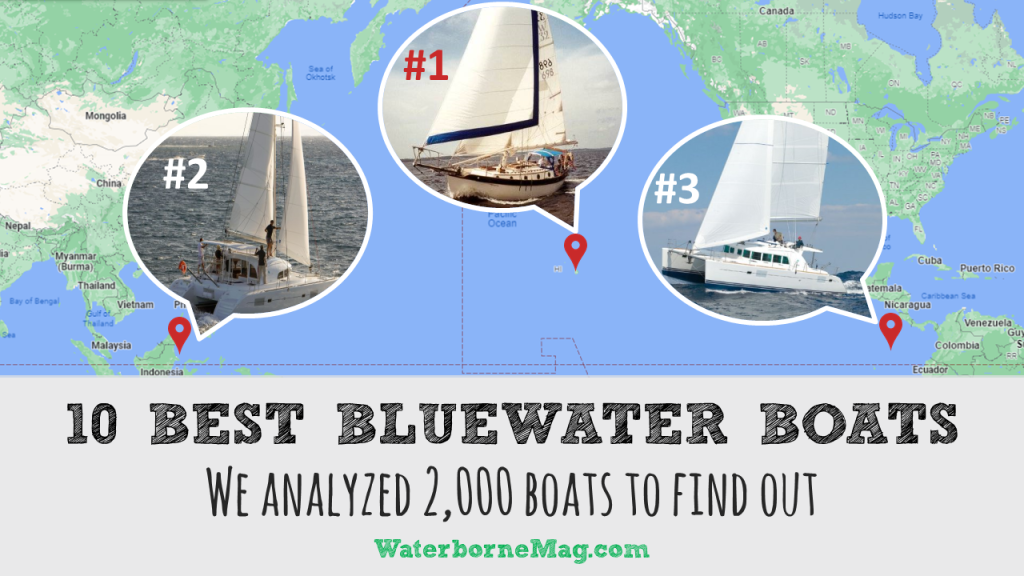
What are the best bluewater sailboats?
This was a question we asked a lot of experienced cruisers when we decided to sail across the Pacific. We needed a boat after all, and we wanted to buy the best bluewater sailboat we could afford.
We heard a lot of strong opinions.
Some sailors thought it was reckless to go offshore in any boat that didn’t have a full keel.
Others prioritized performance, and wouldn’t dream of going anywhere in a slow boat like the Westsail 32 (a.k.a. a “Wet Snail 32”).
Opinions like these left us feeling confused like we had to choose between safety and performance.
If we learned anything from these conversations, it’s that what makes a bluewater boat is a hotly debated topic!
However, there’s a way to cut through all the opinions and get to the bottom of it. The solution is….
We analyzed just under 2,000 boats embarking on ocean crossings (over a 12 year time period) and came up with a list of the ten best bluewater sailboats.
Where did we get our data?
The data for our best bluewater sailboats list comes from 12 years of entries in the Pacific Puddle Jump (PPJ), an annual cross-Pacific rally. We took part in 2017 and had a ball!
You can read about the methodology we used to analyze this data at the bottom of the post.
What do we mean by “best”?
We know, that word is overused on the internet!
Simply, based on our data set, these were the most common makes and models entered in the PPJ cross-Pacific rally. There were at least 10 PPJ rally entries for every make of boat on our top 10 list.
So, these boats are 100% good to go?
No! A bluewater boat isn’t necessarily a seaworthy boat. Almost every cruiser we know made substantial repairs and additions to get their offshore boat ready, adding watermakers , life rafts, solar panels, and more.
Also, you should always have a boat inspected by a professional and accredited marine surveyor before buying it or taking it offshore.
But my bluewater baby boat isn’t on this list!?
There are hundreds of excellent bluewater yachts that are not on this list. For instance, we sailed across the Pacific in a Dufour 35, which didn’t even come close to making our top 10 list.
Choosing the right boat is very much an individual journey.
Where can I find these bluewater boats for sale?
We recognize that a top 10 list won’t get you very far if you’re shopping for a bluewater boat (especially if you’re looking in the used market).
So, to help you find your perfect boat, we’re going to create a big list of bluewater boats that you can use to refine your search on Yachtworld, Craigslist, or any other places to buy a used boat .
Sign up for our newsletter to get our big list of bluewater boats list as soon as it comes out.
We’re also working on a series of posts by size class. For example, if you’re looking for a smaller boat, you can narrow it down to the best bluewater sailboats under 40 feet .
Takeaways from our analysis
There were no big surprises on an individual boat level. All of these makes are considered good cruisers, some of them are even best-selling designs! However, there were a few things that caught our eye.
“Go simple, go small, go now” still holds water
We were thrilled to see the smallest boat in our roundup at the very top of the list! Westsail 32 owners can take pride in their small but mighty yachts (and ignore all those snail-sayers).
While undoubtedly there’s been a trend towards bigger bluewater cruisers in recent years, small cruising sailboats seem to be holding their own. 60% of the monohulls on this list were under 40 feet (if you count the Valiant 40 which sneaks just under at 39.92 feet).
Cat got our tongue
So, we knew catamarans were a thing, but we didn’t fully appreciate HOW popular they’d become!
50% of our top 10 bluewater boat list consists of catamarans—a good fact to toss out the next time you’re trying to garner a happy hour invite on the party boat next door (which will undoubtedly be a catamaran).
Still got it!
We’ve got good news for all you good old boat lovers! 60% of the boats on our list were first built before 2000.
While these older models are less performance-oriented than modern designs, cruisers value these boats for their ability to stand up to rough seas and heavy weather. It just goes to show that solid bones and classic looks never go out of style.
Alright, without further ado, let’s dive into our list of the 10 best bluewater boats!
The 10 best bluewater boats
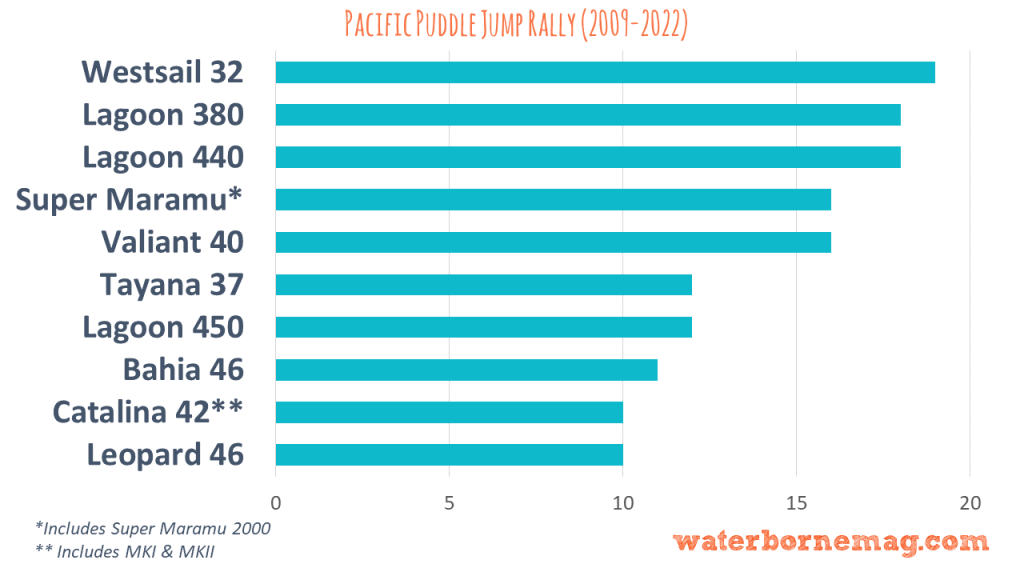
1. Westsail 32
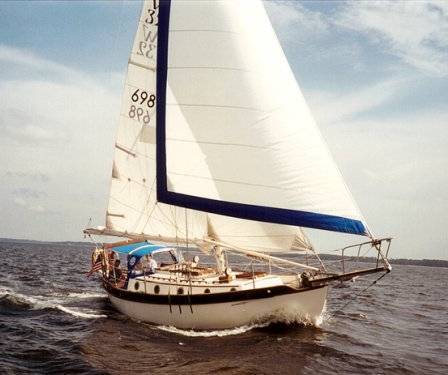
The Westsail 32 is one of the most iconic bluewater cruisers and 19 have set out to cross the Pacific in the PPJ rally since 2009.
In 1973, this small cruising sailboat garnered a 4-page spread in Time magazine. The article inspired many Americans to set sail and the Westsail 32, with its double-ender design, set the standard for what a real bluewater cruiser should look like.
There were approximately 830 built between 1971 and 1980.
This small boat has taken sailors on ocean crossings and circumnavigations. Though considered “slow” by some, the heavily-built Westsail 32 has developed a loyal following for her other excellent offshore cruising characteristics.
If you’re interested in small bluewater sailboats, check out our post on the best small sailboats for sailing around the world .
| LOA | 32.00 ft / 9.75 m |
| First built | 1971 |
| Builder | Westsail (USA) |
| Designer | W. Crealock / W. Atkin |
| Hull type | Long keel, trans. hung rudder |
| Rig type | Cutter |
| Displacement | 19,500 lb / 8,845 kg |
2. Lagoon 380
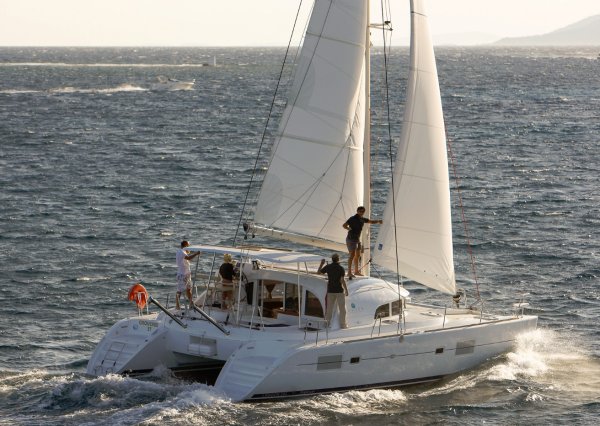
The Lagoon 380 is a reliable, solidly built catamaran and considered roomy for its size. We counted 18 of them in our data set. With over 800 boats built , it may be one of the best-selling catamarans in the world. Like the other boats on this list, the Lagoon 380 has proven itself on long passages and ocean crossings, winning it many loyal fans.
| LOA | 37.89 ft / 11.55 m |
| First built | 2000 |
| Builder | Jeanneau (FRA) |
| Designer | V. Peteghem / L. Prévost |
| type | Cat. twin keel |
| Rig type | Fractional sloop |
| Displacement | 16,005 lb / 7,260 kg |
| More specifications |
3. Lagoon 440
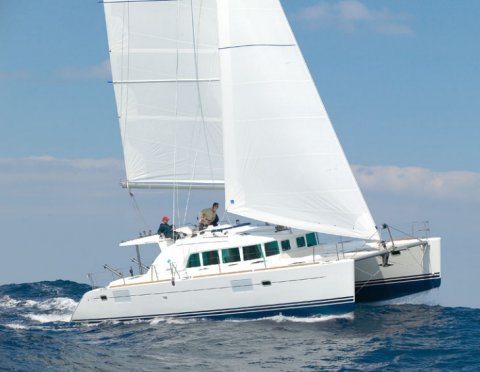
18 Lagoon 440s have set out to cross the Pacific in the PPJ rally since 2009.
Why leave the comforts of home, when you can take them with you? The Lagoon 440 is a luxurious long-range cruiser, offering beautiful wood joinery, spacious accommodations, and a deluxe galley. Oh, and you have the option of an electric boat motor !
SAIL and Sailing Magazine have both done in-depth reviews of the Lagoon 440 if you want to learn more.
| LOA | 44.65 ft / 13.61 m |
| First built | 2004 |
| Builder | Lagoon (FRA) |
| Designer | V. Peteghem / L. Prévost |
| Hull type | Cat. twin keel |
| Rig type | Fractional sloop |
| Displacement | 26,786 lb / 12,150 kg |
4. Amel Super Maramu (incl. SM 2000)
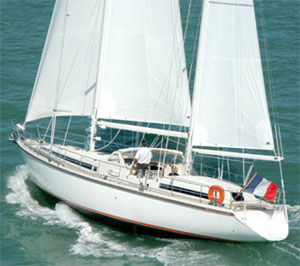
If you follow the adventures of SV Delos on YouTube, you probably know that the star of the show (SV Delos— in case the title didn’t give it away ) is an Amel Super Maramu. These classic bluewater sailboats can be found all over the world, proof they can go the distance.
We counted 16 Amel Super Maramus and Super Maramu 2000s in our list of PPJ entries.
Ready to join the cult of Amel? Read more about the iconic brand in Yachting World.
| LOA | 52.49 ft / 16.00 m |
| First built | 1989 |
| Builder | Amel (FRA) |
| Designer | H. Amel / J. Carteau |
| Hull type | Wing keel |
| Rig type | Masthead ketch |
| Displacement | 35,274 lb / 16,000 kg |
5. Valiant 40
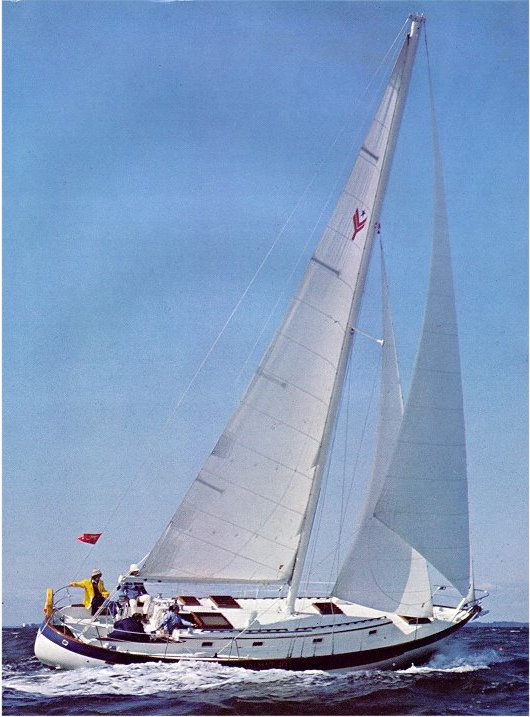
When I interviewed legendary yacht designer, Bob Perry, for Good Old Boat in 2019, he told me that the Valiant 40 was one of the boats that most defined him and marked the real start of his career.
At the time, heavy displacement cruisers were considered sluggish and slow, especially in light winds.
Perry’s innovation with the Valiant 40 was to combine a classic double ender above the waterline, with an IOR racing hull shape below the waterline. The result was the first “performance cruiser”, a blockbuster hit, with over 200 boats built in the 1970s.
It’s no surprise we counted 16 Valiant 40s in our data set.
Cruising World magazine dubbed it “a fast, comfortable, and safe cruising yacht,” and there’s no doubt it’s covered some serious nautical miles.
It’s worth noting that there were blistering problems with hull numbers 120-249 (boats built between 1976 and 1981). Later models did not have this problem. Despite the blistering issues, the Valiant 40 remains one of the most highly thought of bluewater designs.
| LOA | 39.92 ft / 12.17 m |
| First built | 1973 |
| Builder | Uniflite/Valiant (USA) |
| Designer | R. Perry |
| Hull type | Fin keel, rudder on skeg |
| Rig type | Cutter |
| Displacement | 23,520 lb / 10,668 kg |
6. TAYANA 37
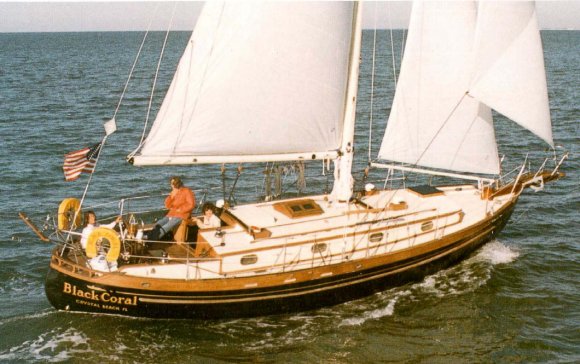
The Tayana 37 is another hugely popular Perry design. The first boat rolled off the production line in 1976 and since then, nearly 600 boats have been built. Beautiful classic lines and a proven track record have won the Tayana 37 a devoted following of offshore enthusiasts.
12 Tayana 37s have set out to cross the Pacific in the PPJ rally since 2009. Read more about the Tayana 37 in this Practical Sailor review .
| LOA | 36.67 ft / 11.18 m |
| First built | 1976 |
| Builder | Ta Yang (TWN) |
| Designer | R. Perry |
| Hull type | Long keel |
| Rig type | Cutter |
| Displacement | 22,500 lb / 10,206 kg |
7. Lagoon 450
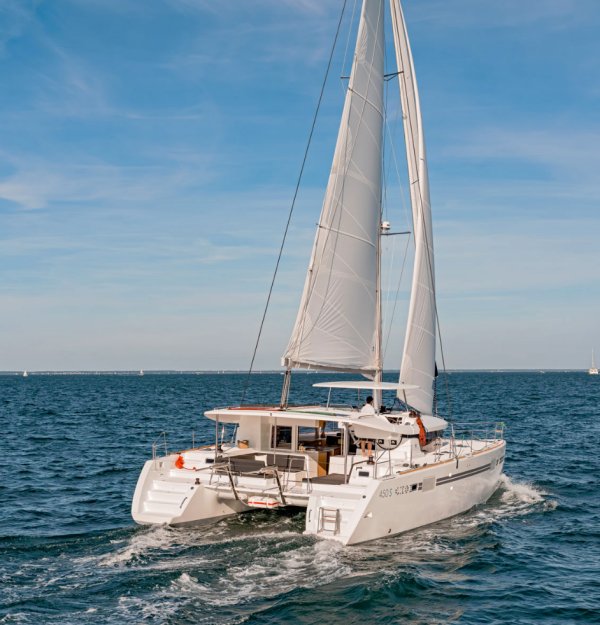
If this list is starting to sound like a paid advertisement, I swear we’re not on Lagoon’s payroll! This is the third Lagoon on our list, but the data doesn’t lie. Lagoon is making some of the best cruising sailboats.
The 450 has been a hot seller for Lagoon, with over 800 built since its launch in 2014. While not a performance cat, the Lagoon 450 travels at a reasonable speed and is brimming with luxury amenities.
At least 12 owners in the PPJ rally chose the Lagoon 450 to take them across the Pacific. It’s no wonder SAIL had so many good things to say about it.
| LOA | 45.80 ft / 13.96 m |
| First built | 2014 |
| Builder | Lagoon (FRA) |
| Designer | V. Peteghem / L. Prévost |
| Hull type | Cat. twin keel |
| Rig type | Fractional sloop |
| Displacement | 33,075 lb / 15,003 kg |
8. Fountaine Pajot Bahia 46
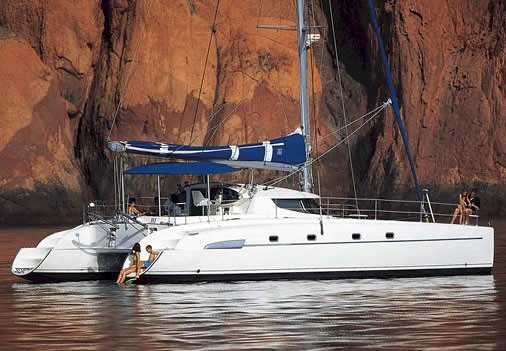
There were 11 Fountaine Pajot Bahia 46s in our data set.
Fountaine Pajot released the Bahia 46 in 1997, a sleek design for traveling long distances. Its generously-sized water and fuel tanks along with ample storage for cruising gear are a real plus for the self-sufficient sailor.
According to Cruising World , “Cruising-cat aficionados should put the Bahia 46 on their “must-see” list.”
| LOA | 46.10 ft / 14.05 m |
| First built | 1997 |
| Builder | Fountaine Pajot (FRA) |
| Designer | Joubert-Nivelt |
| Hull type | Cat. twin keel |
| Rig type | Fractional sloop |
| Displacement | 21,385 lb / 9,700 kg |
| See |
9. Catalina 42 (MKI, MKII)
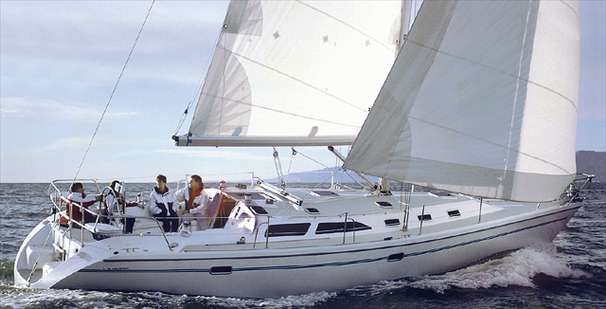
10 Catalina 42s (MKI and MKII) have set out to cross the Pacific in the PPJ rally since 2009.
The Catalina 42 was designed under the guidance of the legendary yacht designer and Catalina’s chief engineer, Gerry Douglas.
One of Catalina’s philosophies is to offer “as much boat for the money as possible,” and the Catalina 42 is no exception. According to Practical Sailor , Catalina aims to price its boats 15% to 20% below major production boats like Hunter and Beneteau.
Practical Sailor has a great in-depth review of the Catalina 42 .
| LOA | 41.86 ft / 12.76 m |
| First built | 1989 |
| Builder | Catalina (USA) |
| Designer | Catalina |
| Hull type | Fin keel, spade rudder |
| Rig type | Masthead sloop |
| Displacement | 20,500 lb / 9,299 kg |
10. Leopard 46
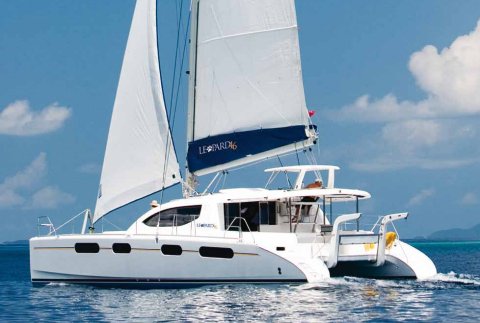
Since 2009, 10 Leopard 46s have embarked on Pacific crossings in the PPJ rally.
Leopards have won legions of fans for their high build quality, robust engineering, and excellent performance.
The Leopard 46 also boasts something of a racing pedigree. It was built in South Africa by Robertson and Caine and designed by Gino Morelli and Pete Melvin, who came up with the record-breaking catamaran Playstation / Cheyenne 125 .
Read more about the Leopard 46 in this Cruising World review .
| LOA | 46.32 ft / 14.12 m |
| First built | 2006 |
| Builder | Robertson & Caine (RSA) |
| Designer | Morelli & Melvin |
| Hull type | Cat. twin keel |
| Rig type | Fractional sloop |
| Displacement | 24,206 lb / 10,980 kg |
Methodology
What the data is and isn’t.
The PPJ data was a real boon because it reflects a wide range of cruising boats: small, big, old, new, expensive, and affordable. We think this may be because the PPJ is a very financially accessible rally—the standard entry cost is $125 or $100 if you’re under 35 (age or boat length!).
We did look at data from other (pricier) rallies but found that the results skewed towards more expensive boats.
Needless to say, the data we used is just a sample of the bluewater boats that crossed the Pacific over the last 10+ years. Many cruisers cross oceans without participating in a rally!
Entries vs. completions
The data we used is a list of the PPJ entries, not necessarily the boats that completed the rally. In instances where we saw the same boat entered multiple years in a row, we assumed they’d postponed their crossing and deleted all but the latest entry to avoid double counting.
Boat make variations
The world of boat building and naming can get pretty complicated. Sometimes a manufacturer changes a boat’s name a year or two into production, other times the name remains the same but the boat undergoes a dramatic update.
For the most part, we’ve used SailboatData.com’s classification system (if they list the boats separately, then we have also), except where there are two separately listed models that have the same LOA, beam, and displacement.
Fiona McGlynn is an award-winning boating writer who created Waterborne as a place to learn about living aboard and traveling the world by sailboat. She has written for boating magazines including BoatUS, SAIL, Cruising World, and Good Old Boat. She’s also a contributing editor at Good Old Boat and BoatUS Magazine. In 2017, Fiona and her husband completed a 3-year, 13,000-mile voyage from Vancouver to Mexico to Australia on their 35-foot sailboat.
Terms and Conditions - Privacy Policy

- Find A School
- Certifications
- North U Sail Trim
- Inside Sailing with Peter Isler
- Docking Made Easy
- Study Quizzes
- Bite-sized Lessons
- Fun Quizzes
- Sailing Challenge

What’s in a Rig? The Ketch
By: Pat Reynolds Sailboat Rigs , Sailboats
What’s in a Rig Series #4
Ketch rigs hold a special place in many a cruising sailor’s heart. There’s something dignified and majestic about them. They are two masted rigs with a main mast and a (smaller) mizzenmast – they carry a jib just like a sloop. Generally, ketches will be in the 40-plus foot range. The reasoning for this is that before sailing hardware and gizmotology (yes, we invented a word) was as advanced as it is now, designers were looking for ways to carry a good amount of sail, but make it manageable at the same time. This configuration served that purpose and while doing so also gave sailors quite a few options for various weather conditions and situations.
Ketch rig sailors speak of the balance that can be achieved with adjusting the various sails in a multitude of ways. There’s a more nuanced control that is achievable through the assortment of trimming permutations. Some take pride in the ability to lock the helm and steer the boat using just the relationship of the multiple sails.
Like cutter rigs, ketch advocates also sing praises for its characteristics in heavier winds. Many will break down the mainsail and go with the mizzen and foresail combo, which can make for a balanced and comfortable ride in more blustery conditions. Factor in reefing and there are a lot of options to depower and find the perfect amount of canvas to fly.
Many fans of the ketch will speak of the mizzenmast as a trusty old friend. It can help stabilize the boat under power, even act like a poor man’s bow thruster at times (a very poor man by the way). And for cruisers, it can also be utilized for more industrious purposes like using it as a crane to pick up a dinghy or some other heavy something or other. You’ll also see many wind generators, antennas and other stuff mounted on mizzenmasts because of their natural excellent positioning for such things.
So the ketch is a definitely a great choice for short-handed cruisers. It has many practical benefits and let’s face it – a pretty ketch, fully rigged and sailing peacefully on a beam-reach, heading somewhere better than where it was…that’s a defining image of what sailboat cruising is. Photo Pat Reynolds.
What's in a Rig Series:

Related Posts:

- Learn To Sail
- Mobile Apps
- Online Courses
- Upcoming Courses
- Sailor Resources
- ASA Log Book
- Bite Sized Lessons
- Knots Made Easy
- Catamaran Challenge
- Sailing Vacations
- Sailing Cruises
- Charter Resources
- International Proficiency Certificate
- Find A Charter
- All Articles
- Sailing Tips
- Sailing Terms
- Destinations
- Environmental
- Initiatives
- Instructor Resources
- Become An Instructor
- Become An ASA School
- Member / Instructor Login
- Affiliate Login

Ketch Sailboats: The Ultimate Guide
An introduction to ketch sailboats:.
Ketch sailboats are a unique and captivating type of sailboat that offers a distinctive sailing experience. In this comprehensive guide, we will explore the design, purpose, key features, rigging options, appropriate buyers and considerations, top brands, and conclude with why ketch sailboats are a remarkable choice for sailing enthusiasts.
Ketch Sailboats: Design and Purpose:
Ketch sailboats are characterized by their two-masted configuration, with a taller mainmast located forward and a shorter mizzen mast positioned aft. This design allows for a versatile sail plan, with various combinations of sails that provide excellent balance and handling. The purpose of ketch sailboats is to offer enhanced control, stability, and ease of handling, making them suitable for both coastal cruising and long-distance passages.
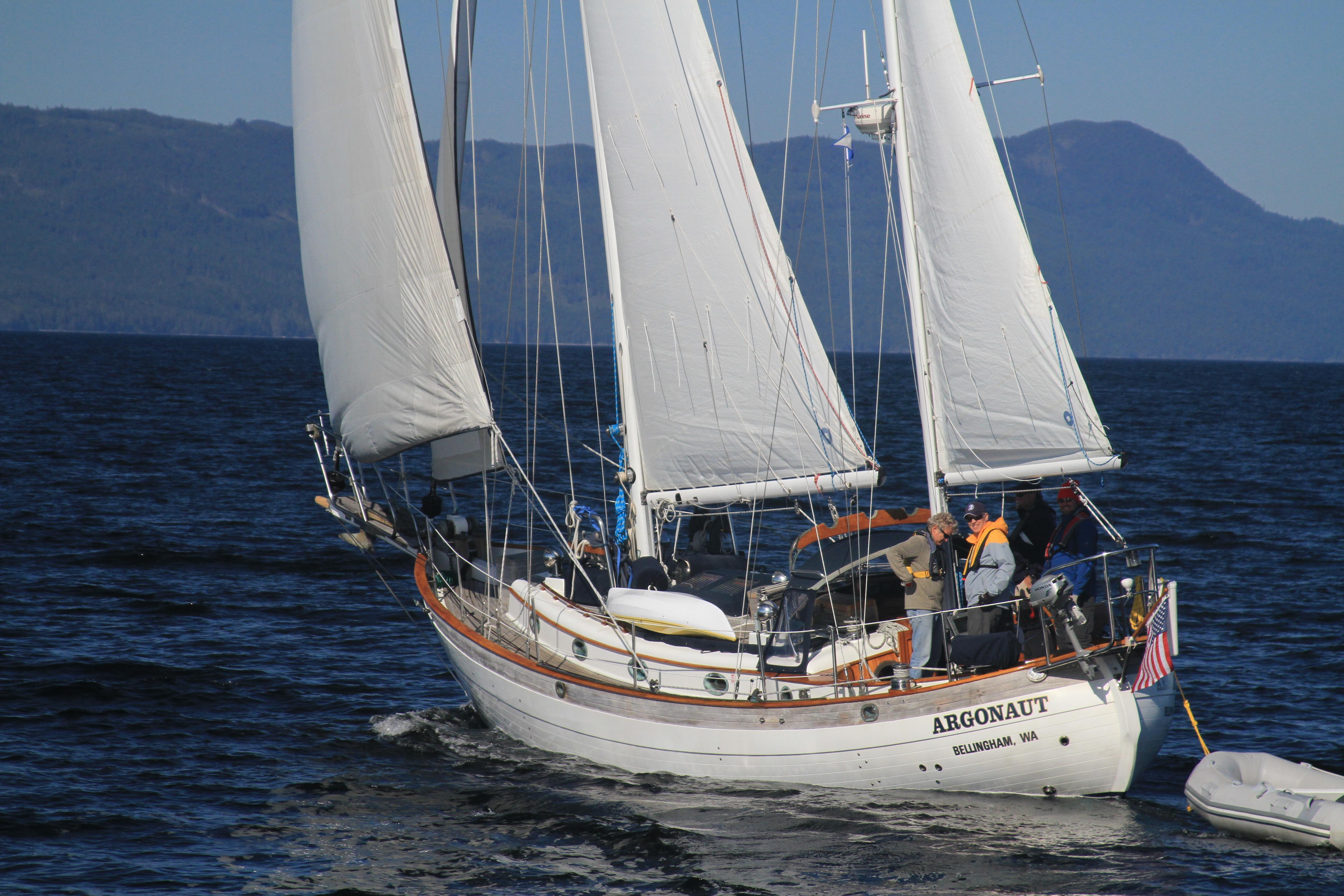
Ketch Key Features:
Enhanced maneuverability:.
The two-masted rig of a ketch sailboat allows for flexible sail combinations, including the option to sail with a mizzen alone. This versatility provides exceptional maneuverability, allowing sailors to adapt to different wind conditions and optimize performance.
Balanced Sailing:
The placement of the mizzen mast aft of the mainmast helps to balance the sail plan. This configuration reduces weather helm, making it easier to maintain a steady course and reducing the strain on the helm. The balanced sail plan also contributes to a comfortable and stable sailing experience.

Comfortable Accommodations:
Ketch sailboats often feature spacious interiors with well-appointed cabins, saloons, and galleys. The additional deck space between the mainmast and mizzen mast provides ample room for lounging and outdoor activities. These features make ketch sailboats ideal for extended stays on the water, offering comfort and livability for onboard living.
Flexible Sail Plan:
Ketch sailboats offer a range of sail combinations, including a mainsail, mizzen sail, jib, genoa, and staysail. This flexibility allows sailors to adjust the sail area to suit prevailing wind conditions, ensuring optimal performance and control.
Rigging on Ketch Sailboats:
Ketch sailboats typically feature a variety of rigging options, including:
- Traditional Ketch: This rig configuration consists of a tall mainmast and a shorter mizzen mast, with a variety of sail combinations available.
- Staysail Ketch: In a staysail ketch, an additional staysail is set between the mainmast and mizzen mast. This rig enhances sailing performance and allows for finer sail adjustments.

Appropriate Buyers and Considerations for Ketch Sailboats:
Ketch sailboats appeal to a range of sailors who value versatility, comfort, and balanced sailing. Consider the following factors when contemplating a ketch sailboat:
- Experienced Sailors: Ketch sailboats require some experience and knowledge to optimize their sail plans and handling characteristics effectively. They are often favored by sailors with a desire for greater control and the ability to fine-tune the rigging for various wind conditions.
- Cruising Enthusiasts: Ketch sailboats are well-suited for cruisers who plan to spend extended periods onboard. The spacious accommodations and comfortable living areas make them ideal for those seeking a comfortable and enjoyable cruising experience.
- Long-Distance Voyages: With their stable and balanced sailing characteristics, ketch sailboats are a popular choice for long-distance passages. Their ability to handle various weather conditions and provide a smooth ride makes them reliable companions on offshore adventures.
Top Brands:
When considering a ketch sailboat, it is crucial to explore reputable brands known for their quality craftsmanship and sailing performance. Here are three top brands worth considering:
Cheoy Lee has established itself as a respected sailboat brand, and their ketch sailboats are highly regarded for their quality and performance. While Cheoy Lee ketch sailboats can primarily be found on the used market, they continue to attract attention from sailors and enthusiasts seeking vessels with solid construction and timeless designs.
One of the standout features of Cheoy Lee ketch sailboats is their exceptional build quality. These boats are known for their sturdy construction and attention to detail, ensuring durability and reliability on the water. Cheoy Lee’s commitment to craftsmanship is evident in the meticulous construction techniques and high-quality materials used in their ketch sailboats.
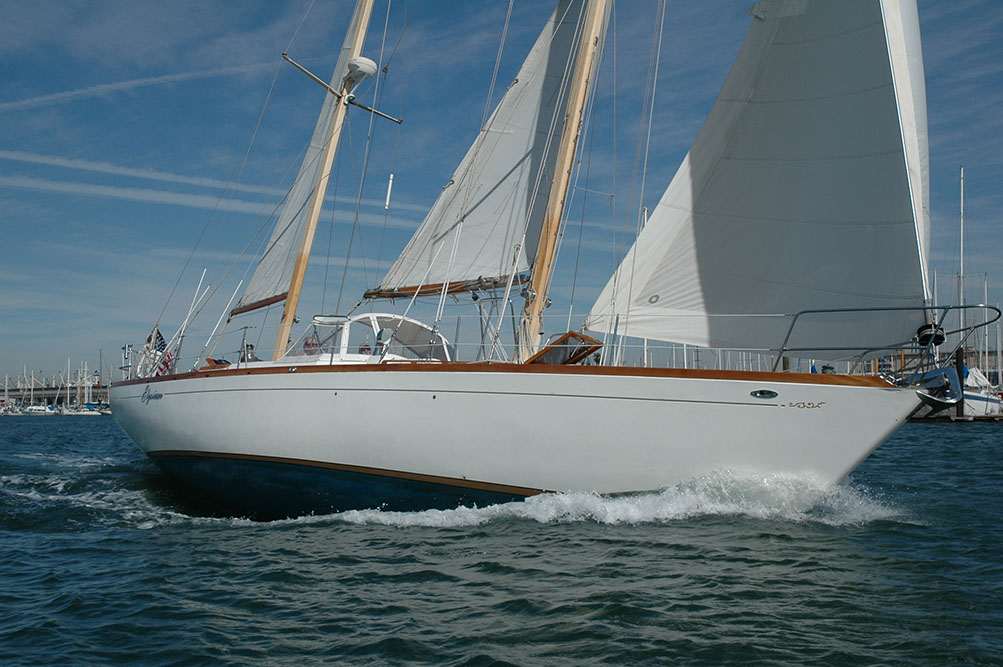
In terms of design, Cheoy Lee ketches often showcase classic lines and graceful profiles that exude elegance and charm. These timeless designs have a lasting appeal and contribute to the overall allure of Cheoy Lee sailboats. The use of teak woodwork, traditional deck layouts, and fine finishes further enhance the classic aesthetic of their ketch sailboats.
Interiors & Seaworthiness
Comfortable interiors are another hallmark of Cheoy Lee ketch sailboats. The cabins and living spaces are designed to provide a comfortable and inviting atmosphere for extended stays on the water. The layout and arrangement of the interior spaces prioritize functionality and convenience, allowing for comfortable living and entertainment onboard.
Seaworthiness is a key aspect of Cheoy Lee ketch sailboats. These vessels are known for their ability to handle various sea conditions with confidence and stability. Whether cruising coastal waters or embarking on offshore passages, Cheoy Lee ketch sailboats offer a solid and dependable sailing experience.
Due to their reputation and enduring popularity, Cheoy Lee ketch sailboats on the used market are often sought after by sailors who appreciate the brand’s commitment to quality, craftsmanship, and classic design. Owning a Cheoy Lee ketch sailboat allows sailors to enjoy the combination of traditional elegance and reliable performance that the brand is known for.
Mason Yachts is a renowned name in the world of sailboats, particularly for their expertise in building high-quality ketch sailboats. These vessels are sought after by sailors who value offshore capabilities, timeless designs, and meticulous craftsmanship.
One of the defining features of Mason ketch sailboats is their exceptional seaworthiness. These boats are designed and built to handle offshore sailing with confidence and reliability. The hulls are carefully constructed to withstand challenging sea conditions, offering stability and a smooth ride. Mason ketch sailboats are known for their ability to handle heavy weather and long-distance passages, making them a popular choice among sailors with a taste for adventure .
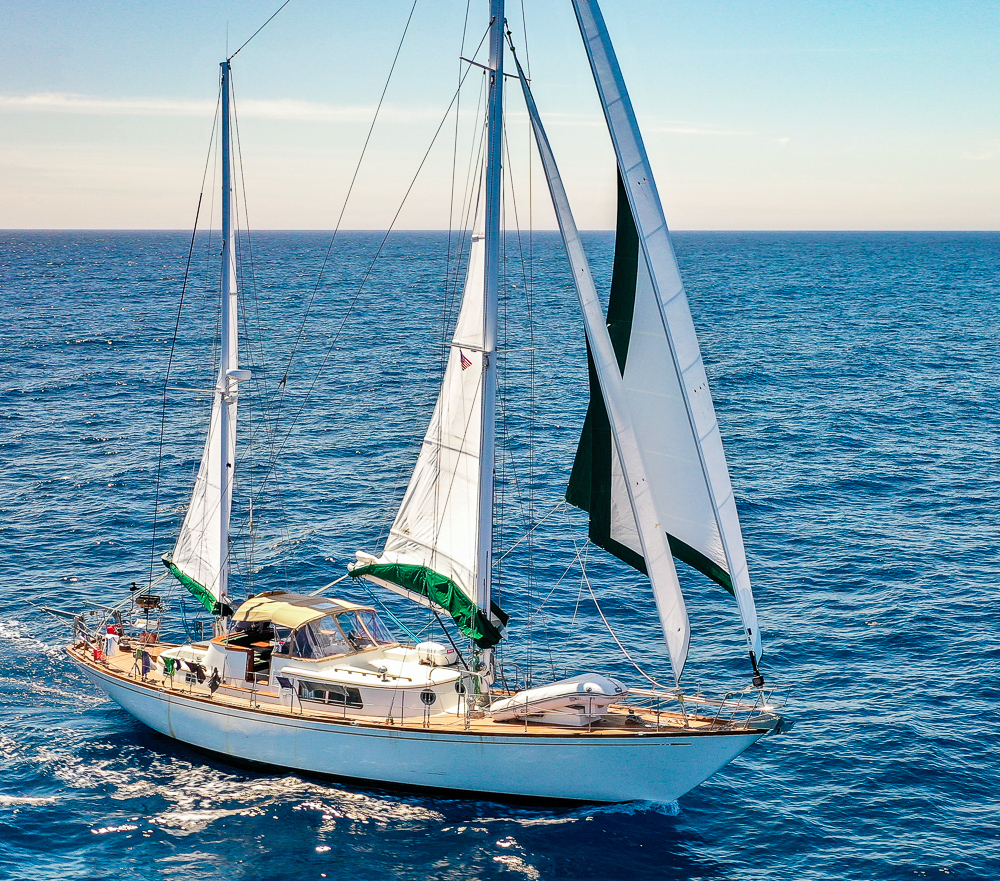
Timeless design is another hallmark of Mason ketch sailboats. These vessels feature classic lines and graceful profiles that evoke a sense of elegance and traditional beauty. Mason Yachts pays meticulous attention to the aesthetics of their sailboats, ensuring that each vessel embodies a timeless appeal that stands the test of time.
Detail & Excellence
Attention to detail is a key aspect of Mason ketch sailboats. From the fine woodwork to the exquisite finishes, every aspect of the boat’s construction is executed with precision and care. The interior spaces are designed to provide comfort and functionality, with well-appointed cabins, spacious saloons, and thoughtfully arranged living areas. The craftsmanship and attention to detail contribute to the overall quality and luxurious feel of Mason ketch sailboats.
Mason Yachts’ commitment to excellence extends to every aspect of their sailboats, from the selection of materials to the rigging and onboard systems. The company is dedicated to building reliable and well-equipped vessels that can withstand the demands of offshore sailing. The attention to detail and the use of high-quality components ensure that Mason ketch sailboats are not only beautiful but also dependable and capable in any sailing conditions.
Hans Christian:
Hans Christian Yachts has established a strong reputation in the sailing community, particularly for its beautifully crafted ketch sailboats. Although primarily found on the used market, Hans Christian ketches continue to captivate sailors with their timeless design, exceptional craftsmanship, and robust construction.
One of the standout features of Hans Christian ketch sailboats is their classic elegance. These vessels are meticulously designed with graceful lines, teak woodwork, and meticulous attention to detail. The combination of traditional design elements and high-quality materials creates a sense of timeless beauty that sets Hans Christian sailboats apart.
Hans Christian ketches are well-regarded for their seaworthiness, making them a popular choice for bluewater cruising and long-distance voyages. The sturdy construction and solid build of these sailboats instill confidence in sailors, allowing them to navigate challenging sea conditions with ease. Hans Christian sailboats are known for their ability to handle offshore passages and provide a smooth and stable ride.

Comfortable and spacious interiors are another highlight of Hans Christian ketch sailboats. The cabins are thoughtfully designed and well-appointed, offering a cozy and inviting atmosphere for extended stays onboard. The saloons provide a comfortable space for relaxation and socializing, while the functional galleys are equipped with the necessary amenities for onboard cooking. The interior layout of Hans Christian ketch prioritizes comfort and functionality, creating a home-like environment for sailors.
Craftsmanship and Capabilities
With their traditional ketch rig, Hans Christian sailboats deliver excellent sailing performance and stability. The two masts and multiple sails allow for versatile sail configurations, enabling sailors to adjust to various wind conditions. The balanced sail plan and well-balanced hull design contribute to the overall performance and maneuverability of these sailboats. Whether navigating calm coastal waters or tackling challenging offshore passages, Hans Christian ketch sailboats offer a reliable and enjoyable sailing experience.
The combination of craftsmanship, reliability, and offshore capabilities makes Hans Christian ketch sailboats highly sought after by sailing enthusiasts. The brand’s commitment to producing sailboats of exceptional quality and enduring appeal has earned them a dedicated following. Owning a Hans Christian ketch sailboat not only provides a means of exploration and adventure but also offers a connection to the rich heritage of traditional yacht design.
Ketch Sailboats Conclusion:
Ketch sailboats offer a unique sailing experience characterized by versatility, balance, and comfort. Their two-masted rigging provides enhanced control and maneuverability, making them suitable for both coastal cruising and long-distance passages. With flexible sail plans, comfortable accommodations, and reliable performance, ketch sailboats are an excellent choice for experienced sailors, cruising enthusiasts, and those embarking on long-distance voyages.
Previous Post When is a Catamaran Worth the Price?
Next post catamaran sailboats: the ultimate guide, related posts.
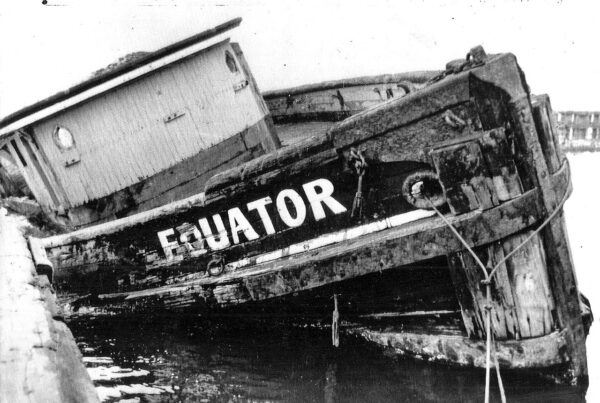
The History of the S.S. Pomona: Porthole to the Present
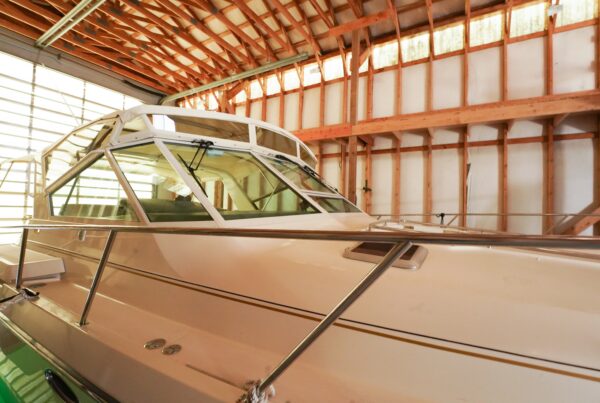
But could it be a Yawl?
It's easy to confuse a ketch sailboat with a yawl so perhaps we should clear that up before we go any further. Both are two-masted rigs with a mainmast foremost and a smaller mizzen mast aft.
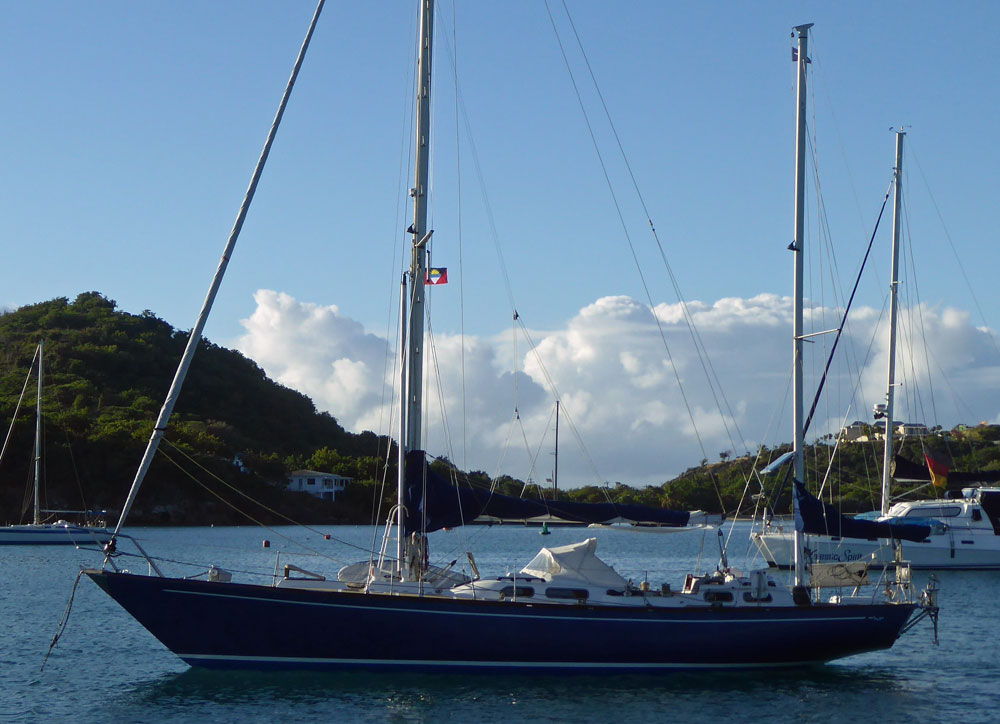
It's generally accepted that the difference between the two types comes down to the location of the mast in relation to the rudder post. In a yawl the mizzen is aft of the rudder post and in the ketch, it's forward.
But the real difference is one of purpose. The mizzen on a yawl is intended to help trim the boat, in capable hands giving them the ability to follow a compass course despite minor wind shifts.
This was a very handy feature in the days when commercial fishing was done under sail, but these days efficient autopilots and navigation aids have made this less important and the yawl has generally fallen out of favour.
| : Mizzen mast ahead of the rudder post | : Mizzen mast aft of the rudder post |
The Mizzen Sail on a Yawl or Ketch Sailboat
The mizzen sail of a ketch is larger than that of a yawl and is there to add drive. And so it does - off the wind.
On the wind though, the mizzen is likely to add nothing but drag, being back-winded most of the time by the mainsail.
In these conditions the mizzen sail may as well be dropped, at which point the ketch becomes in effect an under-canvassed sloop.
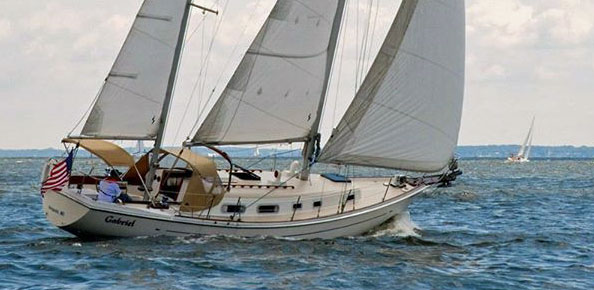
The Mizzen Staysail
Off the wind a ketch is at its most efficient, particularly so if cutter rigged and with a mizzen staysail set.
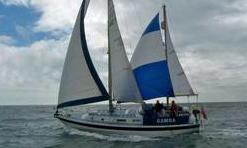
That's the sail set between the head of the mizzen mast and the foot of the main mast, as on the Westerly 33 shown here.
But all the additional hardware - mizzen mast, sails, winches, standing and running rigging - comes with a considerable cost burden.
But there are benefits to be had from a split rig of a ketch:~
- First, they offer greater flexibility for sail reduction, allowing a jib and mizzen configuration in strong winds;
- secondly, at anchor where with the mizzen set as a steadying sail, the boat will lay comfortably head-to-wind.
The Triatic Backstay
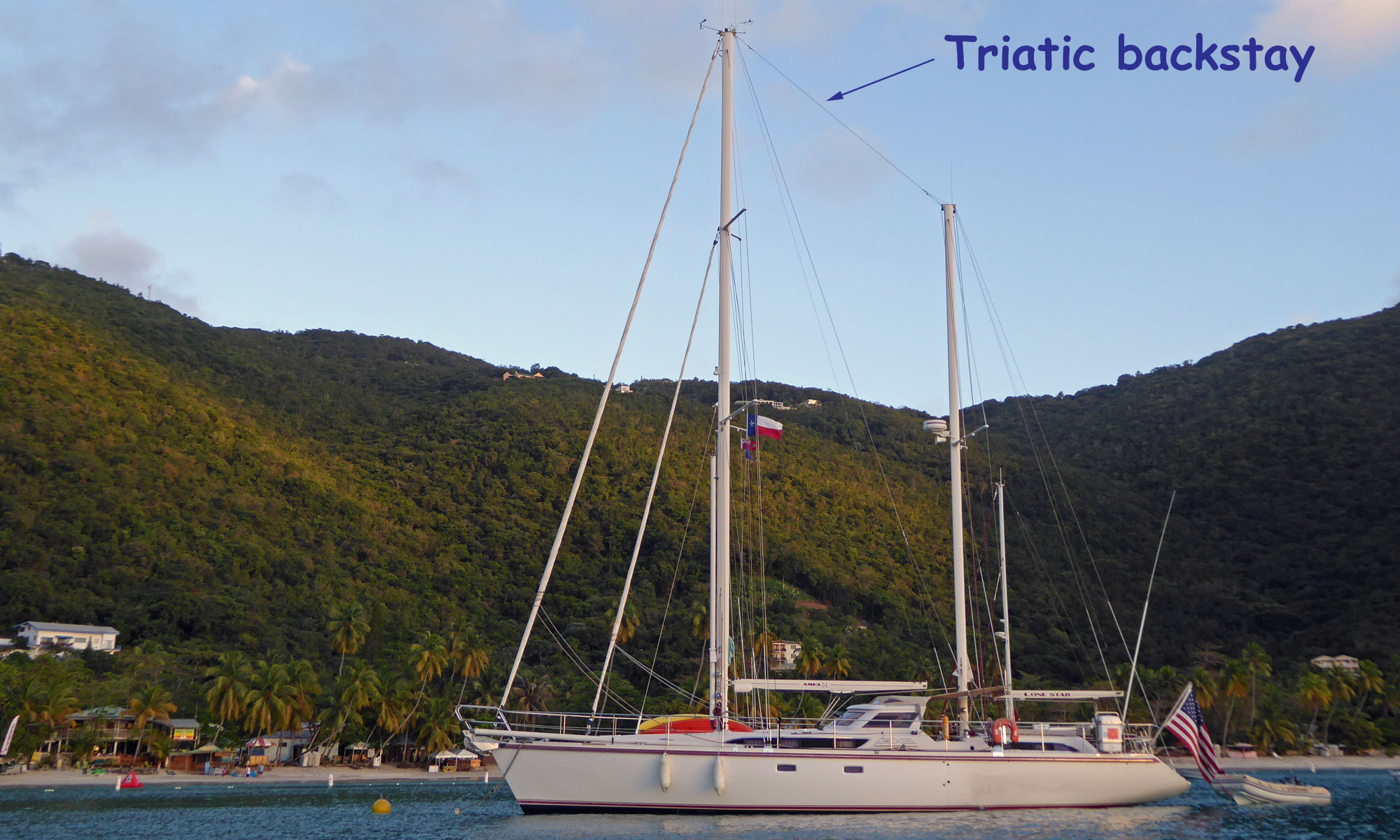
Although you'll see many ketch sailboats with a triatic backstay tensioned between the two mastheads, each mast should be stayed individually.
Whilst this stay is ideally placed to act as an insulated SSB radio aerial, in the event of the loss of one mast it's almost guaranteed to result in the loss of the other.
A staysail ketch like the Amel 54 shown above will carry the following suit of working sails:
- mizzen staysail;
A cruising sloop of a similar size has only two sails to make up the same sail area, which would be considerably more difficult for a short-handed crew to handle.
So, in answer to the original question, although they're not the best choice for windward sailing, the ketch can make an ideal cruising sailboat.
Lastly, the mizzen mast on a ketch sailboat provides an ideal place to mount your radar scanner and wind generator. And as one old sea-dog once told me, a convenient thing to lean against when you're smoking your pipe.
A Few Examples of Ketch Rigged Cruising Boats
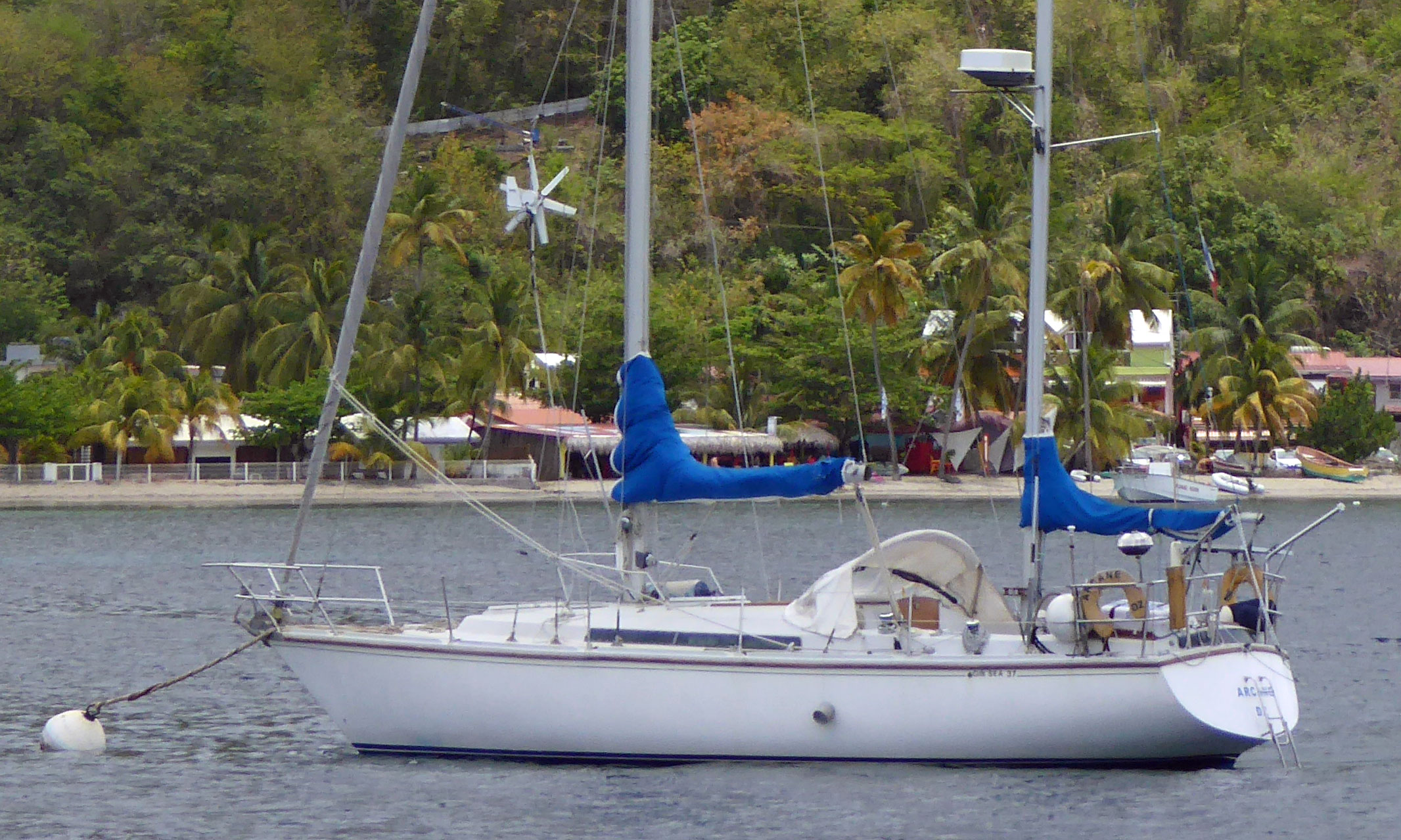
What are the Pros & Cons of a Ketch?
- Spread of Sail: Ketches have their sail area distributed over a higher number of sails, which means the size of each sail is generally smaller when compared to a sloop. This is useful when conditions are rough, as it's easier and safer to handle smaller sails.
- Rig Options: The ability to switch between sail configurations makes ketches versatile. You can use only the mizzen and jib in a strong wind, only the main in moderate wind, and all sails in a light wind.
- Downwind Efficiency: Ketches tend to perform well when sailing downwind, as the mizzen sail helps to catch additional wind.
- Balance: The mizzen sail aids in stabilizing the boat which is useful when minimizing roll at anchor and helps balance the boat under sail.
- Emergency Steering: The mizzen sail can be used for emergency steering if the rudder or main steering system becomes damaged.
- Cost: Ketches often cost more due to the additional rigging and hardware needed for the extra mast and extra sails.
- Maintenance: More rigging and more sails also mean more maintenance. Ketches may require more effort and cost to uphold.
- Windward Performance: Ketches are often outperformed by sloops or cutters when sailing upwind.
- Maneuverability: The extra mast can complicate tacking and jibing maneuvers, particularly in heavier winds.
- Space Occupancy: The mizzen mast in a ketch can limit the space available in the cockpit or aft areas.
It's important to note the pros and cons can vary based on the specific design of the ketch. Certain designs may mitigate some of the cons, and other pros may become more apparent in certain types of conditions.
What are the ideal sailing conditions and environments for a ketch sailboat?
Ketch sailboats are particularly suited for long-distance cruising and offshore sailing because of their stability, versatility in sail arrangements, and downwind performance. They perform best in moderate to heavy wind conditions where the additional mizzen sail can provide extra balance, power, and control.
These boats shine when sailing downwind or on reaches, where their additional sails can make full use of the wind. They also work well in heavy wind conditions where reducing sail area is necessary, as their multiple smaller sails can provide more manageable options.
In terms of environments, ketches tend to thrive in areas with consistent winds and open water, such as offshore or coastal cruising routes. Their stability and easy handling can be advantageous in rough sea states or when navigating rolling swells.
However, it's worth mentioning that the performance of a ketch can depend on the specific design of the boat, the skipper's sailing skills and the crew's ability to manage and adjust the sails on board.
Recent Articles
The Sigma 33 Sailboat
Jul 09, 24 09:40 AM
The Moody 54 Sailboat
Jun 29, 24 02:09 AM
The Brewer 44 Sailboat
Jun 28, 24 03:21 AM
Here's where to:
- Find Used Sailboats for Sale...
- Find Used Sailing Gear for Sale...
- List your Sailboat for Sale...
- List your Used Sailing Gear...
Our eBooks...

Cruising Boats...
Our ever-growing gallery of pics and basic specifications of many popular cruising boats...
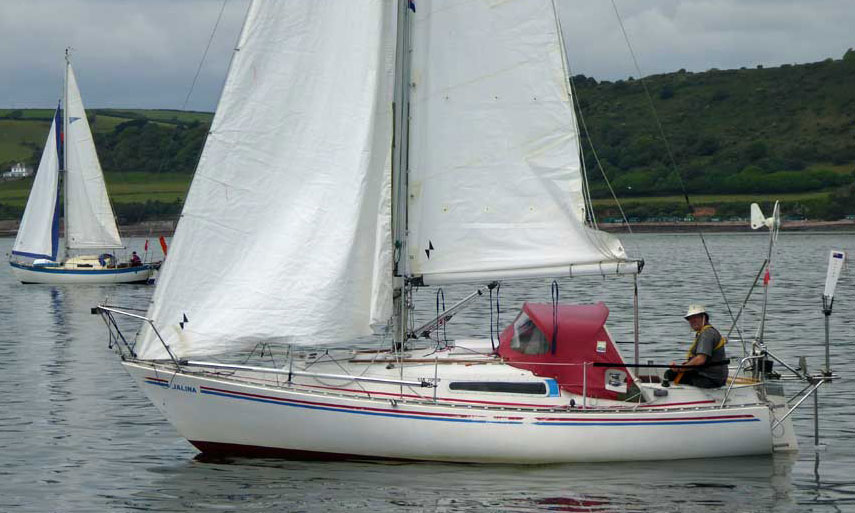
A few of our Most Popular Pages...

Copyright © 2024 Dick McClary Sailboat-Cruising.com
- New Sailboats
- Sailboats 21-30ft
- Sailboats 31-35ft
- Sailboats 36-40ft
- Sailboats Over 40ft
- Sailboats Under 21feet
- used_sailboats
- Apps and Computer Programs
- Communications
- Fishfinders
- Handheld Electronics
- Plotters MFDS Rradar
- Wind, Speed & Depth Instruments
- Anchoring Mooring
- Running Rigging
- Sails Canvas
- Standing Rigging
- Diesel Engines
- Off Grid Energy
- Cleaning Waxing
- DIY Projects
- Repair, Tools & Materials
- Spare Parts
- Tools & Gadgets
- Cabin Comfort
- Ventilation
- Footwear Apparel
- Foul Weather Gear
- Mailport & PS Advisor
- Inside Practical Sailor Blog
- Activate My Web Access
- Reset Password
- Customer Service

- Free Newsletter

CS 30 Used Boat Review
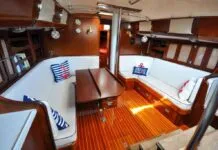
Hinckley 49 Used Boat Review

Island Packet 31 Used Boat Review

Hallberg-Rassy 42 Used Boat Review

Best Crimpers and Strippers for Fixing Marine Electrical Connectors

Thinking Through a Solar Power Installation

How Does the Gulf Stream Influence our Weather?

Can You Run a Marine Air-Conditioner on Battery Power?

Master the Sailing Basics: Never Stop Learning the Little Things

How to Mount Your Camera on Deck: Record Your Adventures with…

Un-Stepping the Mast for America’s Great Loop
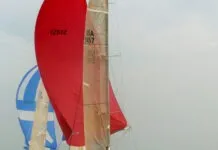
Headsails and Spinnakers: How to Explain Their Functions to a Beginner

Sinking? Check Your Stuffing Box

The Rain Catcher’s Guide

How to Change Your Engine Mounts

Keeping Water Clean and Fresh

Vinyl Boat Lettering DIY Application and Repair

Those Extras you Don’t Need But Love to Have

Three-Model BBQ Test
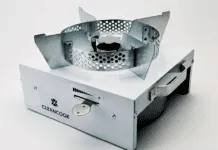
Alcohol Stoves— Swan Song or Rebirth?

Womens Foul-Weather Gear

Preparing Yourself for Solo Sailing

How to Select Crew for a Passage or Delivery

Preparing A Boat to Sail Solo

Chafe Protection for Dock Lines

Waxing and Polishing Your Boat

Reducing Engine Room Noise


Tricks and Tips to Forming Do-it-yourself Rigging Terminals

Marine Toilet Maintenance Tips
- Inside Practical Sailor
A One-sided Defense of the Cruising Ketch

This week I had the opportunity to poke around a ketch-rigged Pearson 424 that was for sale in the neighborhood, and although they’ve generally fallen out of favor today, I was reminded of the many advantages of the ketch design. The Pearson 424 is an example of several decades-old production boats that were offered in a variety of rigs (sloop, cutter, or ketch), which has given longtime owners an opportunity to compare sail plans.
Judging from Pearson 424 list prices and bulletin board discussions about the Pearson 424, it appears that the scales are slightly tilted in favor of the sloop and cutter versions. However, the ketch owners are equally emphatic regarding their boats’ positive attributes. Having covered most of my cruising miles aboard a ketch, I’m an impartial party in this debate. So keep in mind, that much of what you read below (redacted from an earlier post of mine) is colored by personal experience.
My affinity for cruising ketches like the Allied Seawind II we feature in the January 2016 issue of Practical Sailor runs contrary to the view of their many detractors. Their criticism goes something like this: Ketches were popular in early days of cruising when undersized winches and friction-bound hardware conspired to make handling large sails a chore. With efficient winches and modern hardware, split rigs are obsolete on boats under 50 feet, they say.
Having wrestled down the main on more than a few 40-footers with state of-the-art everything, I don’t buy this argument, but I’ll let it stand. Nor will I quibble over complaints about a ketchs handicap to windward-which in my view is overstated, at least with regards to the better designs. Being the first boat to reach a windward watering hole is nice, but it’s hardly the first feature you look for in a good cruising boat.
You can explore the cruising blogosphere and find plenty of resident ketch-haters, and indeed, some of the complaints have merit; the added weight and expense of the ketchs extra rigging are irrefutable knocks. But having lived aboard and sailed a much-beloved, 32-foot William Atkin ketch for 10 years, I’m not interested in joining the chorus. Instead, I celebrate the rigs attractions, especially to the short-handed cruiser.
- Smaller sails are easier to handle. In squally weather, start with a reef tucked in the main, then just furl the mizzen or jib as needed without leaving the cockpit, upsetting helm, or wrestling more reefs into the main.
- Ride the invisible rail. The fore-and-aft distribution of sails simplifies the task of achieving a rock-steady helm.
- Impress your sloop-sailing friends with fancy ketch tricks. Sail backward through the mooring field (spin circles if you have a sharpie), nose casually up to anchor, hove-to with jig and jigger.
- Barrel westward on a reach. Turbo-charge off-wind sailing by setting a mizzen staysail.
- Don’t fear a dismasting. Having two independently stayed masts increases your odds of having at least one spar to use for jury rigging. (This advantage does not apply to ketches with triatic stays like the lovely Sea Witch.)
- Sail in good company. Some famous ketches to consider: Steinlager 2 (1990 Whitbread winner), Suhaili (Robin Knox Johnstons Golden Globe race winner), Joshua (Bernard Moitessiers beloved, steel globe-trotter), Wanderer IV (Eric and Susan Hiscocks storied cruiser), Colin Archers heroic little rescue boats . . . the list goes on.
- Draw longing sighs from those ashore. There is something about having a main and mizzen working together that kindles romantic visions of South Sea islands.
Another nice thing about ketches is that many have reached an age when they are true bargains. Here are just a few familiar ketches worth considering: L. Francis Herreshoffs classic H-28, Gary Hoyts unstayed Freedom 40, Charlie Morgans family-friendly Bahama-mama Out Island 41, Ted Brewers Whitby 42 (aka Brewer 12.8), the Cheoy Lee Offshore 41, any of William Gardens iconic ketches, the Swedish-built Hallberg-Rassy 42, Atkins Ingrid 38 (and her related offspring), John Hannas iconic Tahiti ketch, Holman & Pyes Bowman 57, and two S&S designs, the Swan 57 and Tartan TOCK.
These are just a few that come to mind. I’m sure PS readers have many other boats to add to the list as evidence that reports on the death of the cruising ketch have been greatly exaggerated.
RELATED ARTICLES MORE FROM AUTHOR
Leave a reply cancel reply.
Log in to leave a comment
Latest Videos
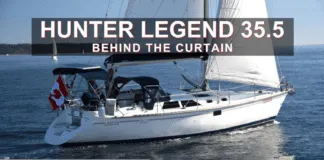
Hunter Legend 35.5 – Behind the Curtain

Whipping Line On Your Sailboat

Hallberg Rassy 42 – Behind the Curtain

The ICW – The Easiest Way – Sail to the Sun...
- Privacy Policy
- Do Not Sell My Personal Information
- Online Account Activation
- Privacy Manager
15 Surprising Benefits of a Ketch Rig (and 7 Cons)
If you're trying to figure out whether the ketch rig is for you, there are a couple of important factors to consider. In this article, I'll sum up the most important benefits.
What are the benefits of a ketch rig? Since the sail area is divided over multiple sails, the ketch is more easily managed and is great for single-handed sailing. It offers more versatility in sail plan, and is known to handle very well in heavy winds. The ketch rig is an especially effective rig for larger boats (40ft and up).
Just a quick recap: the ketch is a two-masted sailboat that has a mainmast (front) and shorter mizzenmast (aft or back). Both masts carry a mainsail. The sail on the mizzenmast is also called the jigger.
Your mizzensail provides all kinds of benefits. There are some really creative ways to put your mizzenmast to use. Read on to learn what those are.

On this page:
The ideal rig for long-distance offshore cruising, ketches generally perform better in downwind conditions, smaller sails are easier to manage, easier reefing, using multiple sails allows for more control, more versatile sail plan options, you gain a spare sail, more balanced sailing, superior sail plan in heavy winds, comfort over speed, less stress on the rigging, variety of mizzenmast uses, the air rudder, free riding sail at anchor, incredibly fast in right conditions, disadvantages of the ketch rig, in conclusion.
All in all, the ketch rig is widely known as one of the best rigs for long-distance cruising . There are multiple reasons to back up that claim, and we'll go over all of them one by one below. But the most important reason is that the ketch is incredibly comfortable, both in handling, maneuvering, operating, and the ride itself. This increased comfort is largely thanks to the extra sail aft, the mizzensail, which provides a better power balance.
So who's it for?
The ketch is especially great for long-distance cruisers that face rough waters and heavier winds and are short-handed. For example, couples that want to sail around the world together, or liveaboards that go on long holidays or expeditions. It's also a great family cruiser, since you can sail a larger boat without needing additional crew members or having to operate humongous sails.
While with the Marconi rig the main and jib get in each other's way on downwind runs, the ketch rig has far fewer problems. The mizzensail and mainsail can work together seamlessly and are far more efficient with most points of sail, except of course when sailing very close to the wind. But even then, the Bermuda rig and ketch can go neck-to-neck and the gap in performance isn't necessarily enormous. Unless you're a racer, the ketch is a really good alternative to the Bermuda rig, and most people should at least consider it.
The ketch is a very good single-handed rig, especially for larger boats (40ft and up). Using smaller but more sails allows you to have more sail area, while it's still manageable for one person. Also, smaller sails are easier to handle in heavier winds . Splitting up your sail area is just a great way to keep things in check, even with a small crew of just one or two people.
Because you have more (and mostly smaller) sails, reefing becomes easier. There's less stress on the sails, and you can reef down gradually, in phases, moving through your sails one by one. This ensures comfortable reefing and results in less speed reduction.
Another great tip I've read somewhere is that you can even quickly drop your main when the winds come in. Instantly, you're storm proof, while maintaining speed and course.
The ketch rig has three primary sails instead of two. This provides all kinds of benefits, and there are a couple of really surprising ones, which I'll come to later on. But the most important one is that you gain more control. The mizzensail provides more control over your stern.
Also, with the additional sail, you get a lot more trimming options for all conditions, allowing you more precise control for each point of sail and with any wind.
The extra sail also provides more versatile sail plan options. You have a broader operating range. There are more sails to put up with light airs, but also more sails to take down when things get rough. You can reef in all kinds of different combinations, and even take down the main if you have to. Which brings me to my next point.
This provides A LOT of benefits. For example, if you need to perform maintenance on your main, you can simply take it down, and continue sailing without losing control or a lot of speed. The ketch can sail on all points of wind with the main down (or the mizzen or jib). You have a spare sail, which will come in handy.
The mizzensail has a major upside you just won't get with the Bermuda sloop rig. The mizzensail balances the jib.
Sailing "jib and jigger" means just using your mizzen and jib, and leaving the mainsail down.
I've heard that this sail plan is very well-balanced, and allows you to self steer in a way. You could theoretically even use it as an temporary alternative to your autopilot, should it break down.
Thanks to its more balanced sail plan, the ketch rig is a much more comfortable ride in heavier winds, and many sailors praise the ketch for precisely that. Taking down the mainsail, sailing just the jigger and jib, provides a sort of instant storm sail plan that at the same time offers a lot more control than the single stormsail you'd usually put up on a Bermuda rig instead of the mainsail.

I think it's clear by now that the ketch is maybe the ultimate cruising rig. If you value your comfort, the mizzen offers some incredible benefits. The well-balanced output of this rig and the enormous variety in sail trim options allow for a smooth ride in almost all conditions.
However, you do pay a (minor) price for all this luxury: speed. The ketch is inevitably slower than the leaner Bermuda rig. However, on a downwind run, the ketch will still satisfy: there's plenty of sail area to gain some nice momentum.
Reducing sail size means you don't have to put as much stress on the rigging and you could use shorter masts, making them stronger. The difference in mast length isn't huge, but the forces on the mast grow exponentially with length. So a bit shorter mast makes a big difference.
In turn, the stress on the rigging is also reduced, which can lead to less wear, resulting in lower maintenance costs.
Stress on the rigging seems to be the major disadvantage of the Marconi rig.
Another rig that's a bit 'softer' is the gaff rig . The gaff rig is better suited for inland, calm waters instead of long term cruising, but can be another good alternative to the uptight Bermuda. I have written about the advantages of the gaff rig in detail in this article (opens in new tab).
The mizzenmast and sail can act as several things and will be very useful to creative sailors. Some cool examples I've found:
You can use the mizzenmast and sail:
- Using it as a crane to load and unload cargo
- Using it as an air rudder
- Using it as your riding sail at anchor
The mizzen can be a great help in mooring and the likes. Many ketch sailors use the mizzenmast as a type of massive wind rudder, which is a great help when you want extra control under sail. If you learn to use the mizzensail, you gain an additional rudder, which increases control over your stern and can help you maneuver in tight spots.
You can also use the mizzensail as an alternative riding sail at anchor, although it isn't recommended since your sail will wear down due to increased UV exposure.
As I pointed out briefly before, the ketch rig is a bit slower than most Bermuda rigs. However, in the right conditions, it can be incredibly fast, especially with larger boats that run a well-balanced sail plan. If you are able to utilize the additional sail area and find a course with a good point of sail, the ketch rig can really ramp up.
As with anything, there is a price to be paid for all these advantages, and the ketch rig does have some downsides. I thought it would be only fair to touch on them briefly below. However, if you are able to look past these, in my opinion, minor disadvantages, the ketch rig remains a great rig for serious sailors.
They tend to be slower than sloops
The Bermuda rig isn't the most popular rig by chance. It is by far the fastest rig out there.
They can't sail as close to the wind as sloops
Although modern ketches can sail almost as high as sloops, there's a point where sloops are able to go, and ketches can go no further. However, I think that many recreational sailors won't push their rig to its limits, which means the ketch is still a good option to consider.
The mizzenmast takes up space
Extra masts and extra sails do take up additional space, and space is precious on your boat.
Most ketches are old boats
Since it is a less popular rig type, there are fewer ketches made than Bermuda sloops. The apparant result being that ketches tend to be a bit older, and are a bit harder to find.
They will be more expensive
Since there are less available, they will be more expensive - the additional mast and sails will obviously also increase your purchase. And it's my guess that most ketches are owned by people who know pretty well what their boat is worth, so it will be harder to find a good bargain.
Additional rigging
Ketches have a lot of additional rigging you just won't find on your regular Bermuda. An extra mast and main means additional sheets, halyards, stays, and so on.
More or less maintenance cost
I have never owned a ketch and I never had to maintain one, so I just don't know whether a ketch is more or less expensive in maintenance. The additional rigging and sails may drive up the maintenance cost; on the other end, the sails are smaller and maybe won't all need replacing at the same rate, which may reduce maintenance cost. Especially the fact that ketch sailors use their mainsail less will probably be really cost-effective. Also, the reduced stress on the mast and (standing) rigging, may reduce maintenance cost.
If you have more experience or information about the cost of ownership and maintenance cost of ketches, please leave a comment below. I'm always eager to learn.
The ketch is a great rig that provides comfort, versatility, and control while offering acceptable speeds and a large operating range. It's a viable alternative to the Bermuda rig, and is especially interesting for people that want to explore the world's oceans with a small crew. It's easy to handle but will be more expensive initially, although I suspect the maintenance cost of the ketch rig will even itself out.
There you have it, all the advantages and disadvantages of the ketch rig in one neat overview. I hope this was helpful and has provided some insight to help you in deciding whether or not the ketch rig is for you.
Seamus Scanlan
I once owned a “Morgan Giles” barrell built wooden sloop which I sailed in the Gair Loch and the Firth of Clyde: what a lovely wee boat that was ! However, that was some years ago and “Things Conspired” and I lost her … I Perhaps Life has changed for the better and now I dream of owning a “Miller Fifer”30 or 35 foot. She should provide live aboard accommodation, carry me through the canals of Europe and see me challenge the Med. Your article on the advantages of the ketch has has inspired and encouraged me greatly and I am sincerely grateful; thank you so much. Seamus.
Please enjoy a HEALTHY 2021.’
It’s a bit confusing and frustrating that you compare a ketch to a Bermuda. Ketch is a sail PLAN, Bermuda is a sail SHAPE. As is gaff, by the way. That rather beautiful photo you used is a gaff sail ketch rig. It gets confusing to newer sailors and causes a bit of skepticism in your accuracy. Otherwise, a well written article. As an (occasional) author, I’ve found that reading what you’ve written a week or so later in a very different font can dramatically help proofreading. A good friend also can’t hurt.
Fair winds and smooth seas!
I made the newbie mistake of buying a 12m used ketch without a survey as a first boat. It sure seems like it would be neat to have, were I experienced. But lots more reading to do. It seems mine is not just a ketch but I am told it is a cutter ketch because there is a space for a yankee. But I assume that is still expected to be slower than your sloop as referenced above?
in 1976 I purchased a brand new, built-for-me, 35’ Challenger ketch. On April 1, 1977, I moved onto my Challenger, which became her name, with my wife, 8 and 12year old sons who had first sailed the year before in a 1969, used, Cal 29. We lived on the Challenger every year from 1977 until I sold her in 1994. My boys, from day one could sail her in any weather, high or low winds or waves. We all loved her sailing on Lake Ontario, NY and Ontario Canada and the St. Lawrence River and 1000 Island and around Kingston Ontario area for 22 days in 1978 only docking for two nights and at anchor the rest of the time. Challenger, with the sails properly set could sail herself either across or down the lake West to east. My wife would sleep and I would sit up in the bow in the pulpit while she sailed. We oftentimes would fly a big light drifter in light winds and a staysail from the main mast head to the End of the mizzen boom. With 5 sails up we would fly. It was sad to let her go but Florida has lots of shallow water.
I appreciate the article as i am looking and trying to understand all the differences and advantages and disadvantages. have owned sloops and never even though of the different rigs as I felt they may be to complicated. I am to find something for some enjoyable cruising and will most likely always be shorthanded with crewing issues. I also appreciated Rehn comments just to make you think. Thank you! for sharing your thoughts
Gene Rossano
I am Gene. almost 30 years ago I sold my Challenger 35 Ketch that I purchased new in 1976 and had her trucked to Buffalo, NY from California to sail on all of Lake Ontario and into the St Lawrence River and the 1000 islands and some channels and locks and small lakes in Ontario, Canada. My wife and I and 8 and 12-year-old sons moved on her on April 1st 1977 and moved off the Challenger November 1st every year until I sold her in 1994 to move to Florida, the land of miles and miles of very shallow water. We sailed her every week leaving on Thursday or Friday and returning either Sunday, Monday, or Tuesday to head back to our home port of Wilson, NY, or later, St Catherines Marina, located in St Catherines, Ontario Canada. We sailed her in every kind of wind and wave condition that we all felt Challenger could and would take us home safely and well. My wife and my boys helmed her and tended the sails day and night in all conditions with every different sail combination that we possessed.All sails were hanked.
Leave a comment
You may also like, 12 surprising advantages of a gaff rig (and some cons).
Interested in the gaff rig, but unsure whether it's for you? Trying to pick the right sail rig type can be a challenge. In order to help you out, I made this list …

Guide to Understanding Sail Rig Types (with Pictures)

The Ultimate Guide to Sail Types and Rigs (with Pictures)

How Much Sailboats Cost On Average (380+ Prices Compared)

41 Sailboat Cruising Essentials for Long Trips

What Is a Ketch Sailboat?

Last Updated by
Daniel Wade
August 30, 2022
Ketch sailboats are a common sight in some areas, and they have numerous handling benefits. But what is a ketch, and how does it differ?
A ketch is a two-mast sailboat similar to a yawl. The mainmast is shorter than a sloop, and the mizzenmast aft is shorter than the mainmast. A ketch usually has a triangular mizzen sail and a triangular or square headsail.
In this article, we’ll cover the general characteristics of a ketch and how to distinguish it from other two-masted sailboats. Additionally, we’ll go over the benefits of the ketch rig and how it compares to the similar yawl rig. We’ll also overview the most common types of ketch sailboats on the water today.
We sourced the information used in this article from sailboat identification guides and rig design diagrams.
Table of contents
General Description of a Ketch Sailboat
A ketch is a two-masted sailboat with a tall mizzenmast mast aft of the mainmast. A key characteristic of Ketch sailboats is that their mizzenmast is shorter than the mainmast.
The mainmast itself is typical and resembles a sloop mast. A ketch has a mainsail and one or more headsails on the mainmast, along with a single mizzen on the mizzenmast.
A ketch can easily be mistaken for a yawl, as these vessels have similar sail arrangements. Ketch sailboats can have square or triangular rigs, depending on the age and specific design of the boat.
A gaff headsail is usually accompanied by a triangular mizzen on a ketch, similar to a schooner.
Ketch Sailboat History
The ketch is a relatively old part of the sailing world. Based on the classic yawl design, the ketch was used extensively for workboats on the New England coast at the height of the sailing era.
Ketch sailboats were robust and easy to handle. They also tracked a naturally straight course due to their mizzen, which was used as a primitive form of self-steering. This was helpful for small fishing boats, as the crew didn’t need to attend to the rudder quite so often.
Ketch sailboats continued working the New England coast well into the era of steam. In the mid to late-1800s, ketch-rigged workboats were still a common sight in coastal areas.
Today, they persist as recreational and cruising sailboats, as their tough and stable rigs are still a practical option for boatbuilders.
Types of Ketch Sailboats
There are many types of ketch sailboats on the water. The ketch is not the most common kind of sailboat, but there are enough of them around to notice once in a while. Ketch sailboats were once utility boats, but they’ve been strictly used for recreational and cruising boats for the last 100 years or so.
The most common kind of ketch is the simple cruising ketch. These sailboats are typically made of fiberglass and resemble other cruising sailboats in almost every way.
Their interior accommodations are the same as a comparably-sized sloop, though cockpit space is limited due to the presence of a mizzenmast and rigging.
The ketch rig is a popular choice for motorsailers, especially heavy-displacement versions. The ketch is a stable design with quite a bit of power due to its additional mast, which allows the mainsail and boom footprint to be slightly smaller. The ketch is also highly controllable, which is great for closed-cockpit sailboats.
The ketch rig is also popular on classic sailboats. Specifically, the gaff-rigged ketch is a common sight in some classic boat circles—particularly on the East Coast of the United States. Wooden ketch-rigged boats were outfitted with both traditional square and modern triangular rigs.
There are a few smaller open-cockpit ketch sailboats around, and these are popular for cruising deeper water—but not far from shore. Open cruising ketch sailboats are usually less than 20 feet long and can be found most often around Chesapeake Bay.
Cutter Ketch Rig
A cutter ketch is simply a ketch rig with additional headsails. Because the mast is in the same position as a sloop, the ketch is easy to rig with additional forward sails. A typical cruising ketch can use a wide variety of headsails, including a spinnaker.
Ketch Vs Yawl
The ketch rig is very similar to the yawl, which also has a tall mainmast and an additional mizzenmast and mizzen aft. The yawl is a much older boat that originated in England or Scotland around the 17th century.
The yawl rig usually has a shorter mizzenmast that’s positioned further aft, as the mizzen boom usually extends beyond the stern of the boat. A ketch mizzen is positioned forward, usually a bit larger and more comparable to the size of the mainsail.
Yawl and ketch rigs are both quite stable. A ketch usually has a bit more power due to its larger mizzen, though the yawl is generally considered to be easier for a single person or a short-handed crew to handle.
Ketch Rig Benefits
There are numerous benefits to the ketch rig, especially when compared to tall Marconi/Bermuda rigs. The primary benefit is that, despite the additional mast and rigging, a ketch is exceptionally easy to handle.
A ketch spreads out its sail area between the headsail, mainsail, and mizzen. The additional mast and sail allow the mainmast to be shortened, which naturally makes the boat easier to control single-handed.
Ketch rigs offer additional precision, as you can adjust three sails independently to optimize performance for any given wind condition. The mizzen is in close proximity to the cockpit, and due to its small size, it’s easy to control.
Ketch rigs can also self-steer to some extent. The mizzen works the same way that a stabilizing sail on a fishing drift boat does and keeps the boat tracking on a straight course with or without constant rudder input from the crew.
The ketch rig also offers a level of redundancy that traditional single-masted sailboats don’t have. This is particularly attractive to long-range cruisers. A ketch has a shorter mainmast, which allows boatbuilders to use stronger materials and maintain the same weight.
A ketch can continue sailing if you lose a mainstay or suffer dismasting, as there’s an additional mast aft that probably won’t also go down. This extra level of safety is useful when conditions are rough, and it also gives you peace of mind when out on the open ocean.
Related Articles
I've personally had thousands of questions about sailing and sailboats over the years. As I learn and experience sailing, and the community, I share the answers that work and make sense to me, here on Life of Sailing.
by this author
Learn About Sailboats
Most Recent

What Does "Sailing By The Lee" Mean?
October 3, 2023

The Best Sailing Schools And Programs: Reviews & Ratings
September 26, 2023
Important Legal Info
Lifeofsailing.com is a participant in the Amazon Services LLC Associates Program, an affiliate advertising program designed to provide a means for sites to earn advertising fees by advertising and linking to Amazon. This site also participates in other affiliate programs and is compensated for referring traffic and business to these companies.
Similar Posts

Affordable Sailboats You Can Build at Home
September 13, 2023

Best Small Sailboat Ornaments
September 12, 2023

Discover the Magic of Hydrofoil Sailboats
December 11, 2023
Popular Posts

Best Liveaboard Catamaran Sailboats
December 28, 2023

Can a Novice Sail Around the World?
Elizabeth O'Malley
June 15, 2022

4 Best Electric Outboard Motors

How Long Did It Take The Vikings To Sail To England?

10 Best Sailboat Brands (And Why)
December 20, 2023

7 Best Places To Liveaboard A Sailboat
Get the best sailing content.
Top Rated Posts
Lifeofsailing.com is a participant in the Amazon Services LLC Associates Program, an affiliate advertising program designed to provide a means for sites to earn advertising fees by advertising and linking to Amazon. This site also participates in other affiliate programs and is compensated for referring traffic and business to these companies. (866) 342-SAIL
© 2024 Life of Sailing Email: [email protected] Address: 11816 Inwood Rd #3024 Dallas, TX 75244 Disclaimer Privacy Policy
Yacht Dreaming
Ketch Sailing Techniques: Mastering the Art of Sailing a Ketch Yacht

Understanding Ketch Sailing Basics
Sailing a ketch yacht is a unique experience that requires a high level of skill and expertise. A ketch is a type of sailboat that has two masts, with a smaller mast located at the stern. The smaller mast is known as the mizzenmast, and it is usually smaller than the main mast.
Ketch sailing is a popular activity among avid sailors, as it offers a range of benefits, including improved stability, increased speed, and excellent maneuverability. To master the art of ketch sailing, you need to understand some of the basics of ketch sailing. Here are some essential tips to get you started:
Tips for Sailing a Ketch Yacht
Understand the wind direction and adjust your sails accordingly. Ketch sailing involves adjusting your sails to the wind direction to maximize your speed and maneuverability. This requires a keen understanding of wind direction and the ability to make quick adjustments to your sails.
Keep an eye on the weather conditions. Sailing a ketch yacht requires you to be aware of the weather conditions at all times. If the weather is too rough, it can be dangerous to sail, so it’s essential to keep an eye on any changes in the weather and adjust your sails accordingly.
Practice your maneuvering skills. Maneuvering a ketch yacht can be challenging, so it’s essential to practice your skills regularly. This includes docking, anchoring, and navigating in tight spaces.
The Art of Ketch Sailing
Ketch sailing is both an art and a science. It requires a high level of skill, experience, and expertise. To sail a ketch yacht successfully, you need to understand the principles of sail trim, navigation, and weather forecasting.
Principles of Sail Trim
Sail trim is one of the most critical aspects of ketch sailing. It involves adjusting the sails to maximize your speed and performance. Proper sail trim is essential to maintain optimal boat balance, which helps to improve stability and speed.
Here are some tips to help you master the art of sail trim:
- Adjust your sails based on the wind direction.
- Use telltales to monitor your sail trim.
- Use the traveler to adjust the position of the boom.
Navigation Techniques
Navigation is another crucial aspect of ketch sailing. It involves using charts, compasses, and other instruments to navigate safely through the water. To sail a ketch yacht successfully, you must understand the basics of navigation.
Here are some essential navigation techniques to help you get started:
- Use charts and maps to plan your route.
- Use a compass to navigate and maintain your heading.
- Use your GPS to monitor your progress and location.
Weather Forecasting
Weather forecasting is an essential skill for any sailor, and it’s especially important for ketch sailors. Understanding the weather can help you avoid dangerous conditions and make the most of favorable winds.
Here are some tips for understanding weather forecasting:
- Monitor the weather forecast regularly.
- Look for signs of changing weather conditions.
- Learn how to read cloud formations and barometric pressure.
Advanced Ketch Sailing Techniques
Once you master the basics of ketch sailing, you can begin to explore more advanced techniques. These techniques can help you improve your speed, performance, and maneuverability.
Advanced Sail Trim Techniques
Advanced sail trim techniques involve adjusting your sails to optimize your speed and performance. These techniques require a high level of skill and experience and can be challenging to master.
Some advanced sail trim techniques include:
- Using the boom vang to control sail shape.
- Adjusting the draft of your sails.
- Using a spinnaker or gennaker to improve your downwind performance.
Advanced Navigation Techniques
Advanced navigation techniques can help you navigate more challenging conditions and explore new areas. These techniques require a deep understanding of navigation principles and a high level of skill.
Some advanced navigation techniques include:
- Using electronic navigation systems.
- Using radar to navigate in fog or low visibility.
- Navigating in challenging conditions, such as heavy seas or strong currents.
Advanced Maneuvering Techniques
Advanced maneuvering techniques can help you navigate in tight spaces and improve your overall sailing skills. These techniques require a high level of skill and experience and can be challenging to master.
Some advanced maneuvering techniques include:
- Using a bow thruster to improve your maneuverability.
- Docking in challenging conditions, such as high winds or strong currents.
- Anchoring in challenging conditions, such as deep water or rocky bottoms.
Sailing a ketch yacht can be a rewarding and challenging experience. It requires a high level of skill, experience, and expertise. To master the art of ketch sailing, you need to understand the basics of sail trim, navigation, and weather forecasting. As you gain more experience, you can begin to explore more advanced techniques, such as advanced sail trim, navigation, and maneuvering techniques.
Sailing a ketch yacht is an art that takes time and practice to perfect. But with dedication and hard work, you can become a skilled and accomplished ketch sailor. So, set sail, explore new waters, and enjoy the thrill of ketch sailing!
Downwind Sailing Techniques: Mastering the Art of Sailing with the Wind
RYA Yacht Sailing Techniques: Mastering the Art of Sailing
© 2024 Yacht Dreaming

- Articles and Guides
Ketch vs Yawl: Comparing Two Classic Sailboat Rigs
14th mar 2023 by toi williams.

Ketches and yawls are popular types of sailboats helmed by sailors around the world. Both are two-masted vessels with divided rigs, meaning the main sail area is divided between the two masts. The taller mast is the main mast while the shorter mast located behind it is called the mizzen mast. In the ketch vs. yawl debate, knowing these mast terms is key to understanding the differences between the two types of sailboats.
So, how can you tell the difference between a yawl and a ketch? Read on to learn everything you need to know about these types of sailboats.
What Is a Ketch?
The easiest way to tell a ketch and a yawl apart is by looking at the location of the mizzen mast. On a ketch, the mizzen mast is in front of the rudder post. The rudder post is where the front part of the rudder attaches to the underside of the boat. On boats steered with a tiller, the rudder post is typically located directly below the end of the tiller handle.
On ketch sailboats , the mizzen mast is shorter than the main mast. These sailboats can have triangular or square rigs, based on the specific design and age of the boat. With the sail area of a ketch split into two parts, the masts can be shorter than that of a single mast ship, so the load on each mast is less. Ketches often have Bermuda sails on both masts, although some modern ketches have gaff sails or both a gaff sail and a Bermuda sail. A ketch that has two or more jibs is called a cutter ketch.

Photo credit: Ronnie Robertson
What Is a Yawl?
A yawl can easily be mistaken for a ketch due to their similar sail arrangements. However, on a yawl, the position and size of the mizzen mast is different. For a yawl, the mizzen mast is much smaller than the one on a ketch and is located far behind the rudder post. This makes the sail area of the mizzen sail on a yawl smaller as well.
The mizzen mast on a yawl balances the sail plan, and the mizzen sail is trimmed for balance. Easing the mizzen sail will make it less effective while over-trimming the mizzen sail will make it more effective. Because the wind force is behind the rudder, the physics of yawl vs. ketch sailing can be very different. Many yawl owners use the yawl’s mizzen sail as a wind rudder when sailing and as a stabilizer when anchoring.

Advantages of a Ketch
Ketches are widely recognized as very versatile sailboats that are highly controllable. Each of the three sails can be adjusted independently for better performance for any given wind condition. The multiple sail configurations achievable make ketches suitable boats for a variety of voyages including day sailing, solo sailing, and sailing in strong winds.
The shorter masts and smaller sails make a ketch easier to handle than larger sailboats. It is also easier to maneuver under bridges without drastically reducing speed. The ketch’s main sail and mizzen sail can work together without the mizzen sail disturbing the main sail. Ketch rigs also have a version of self-steering, keeping the boat tracking on a straight course without constant rudder input.
For the last century, ketches have primarily been used as recreational and cruising boats. A simple cruising ketch is typically made of fiberglass, and its interior accommodations are spacious, although the cockpit space is limited because of both the mizzen mast and the rigging. A ketch usually has a bit more power than a yawl due to its larger mizzen sail.
Advantages of a Yawl
Like a ketch, a yawl is considered to be a very stable boat style that performs well in strong winds. Both can have their sails placed in multiple configurations depending on the weather conditions, making them a good selection for a wide range of sailing activities. Because the main sail is smaller and more manageable, yawls are popular with single-handed sailors. They also like that the smaller mizzen sail can be trimmed to stay on a course easily or lowered when winds pick up to reduce sail area.
Another advantage for a yawl vs. ketch is that a yawl's mizzen mast is far enough aft for the mizzen sail to really affect the position of the stern. A yawl's mizzen sail can be used to help turn the boat quickly or slow it down while sailing. It is also easy to balance against a head sail, letting sailors navigate in strong winds with the main sail furled.
For boaters interested in blue water cruising , a yawl is often the preferable option. In addition to its stability in open water, setting the mizzen sail at a particular wind angle results in reliable wind steering. If the boat veers from the course you have set it on, the mizzen sail will take the wind and push the stern back to the correct course automatically. This set wind angle can be held for long periods without help, freeing you for other tasks.
At Rightboat, we have a wide selection of ketches and yawls in a variety of styles and sizes to fit any sailor's boating needs. You can find the right sailboat for your family and your budget by using the handy filtering tools on our website to narrow your results by size, price, and an assortment of other features. You can also search by location to see which boats we have available nearby. Our collection of new and used sailboats for sale adds new vessels frequently. Come and take a look at what we have to offer.
This article was most recently updated by John Burnham.
Written By: Toi Williams
More from: Toi Williams
Related Articles and Guides
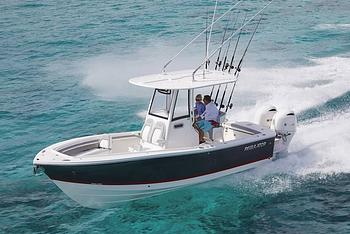
28th Jun 2024
Best Center Console Boats: The Best Brands Across the Spectrum
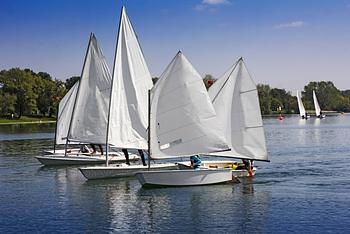
23rd Jun 2024
Small Sailboat Types: Sail Smaller and Savor It All
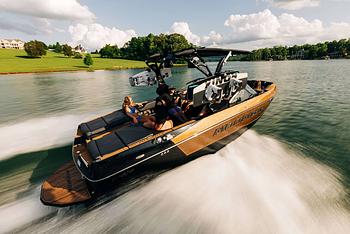
22nd Jun 2024
The Best Wake Boat Brands, a Complete Guide

17th Jun 2024
Best Marine Binoculars: Which Features Make a Difference?
- Explore Rightboat
- Boats for Sale
- Boating Articles
- Buyers Guide
- About RightBoat
- Sell Your Boat
- Boat Selling Advice
- All manufacturers
- All categories
Enter your email to keep up to date with the latest news
Join for free
Sign up now for free and discover how easy it is to keep up to date with THE latest boats for sale. Find your right boat, and tailor your voyage to finding your next boat.
Benefits of becoming a member:
- Set up tailored alerts
- Personalise your experience
- Download full specifications and broker details
- Keep tabs on your favourite boats
Are you a broker? Join as a Broker
Rightboat - join for free.
Do you have an account already? Login
Save this search
Save your search and receive new boats in your email..
You can unsubscribe from your alerts whenever you like. By pressing the button you accept the Legal Terms and conditions

11 Best Single Handed Bluewater Sailboats

Sharing is caring!
We know that you’re serious about sailing when you finally think of venturing to the ocean. Who can resist dreaming of solo sailing through the Atlantic? This is an adventure to prove your advanced skills, strength, and experience.
But before going off on your ocean adventure, you need to plan and prepare . We cannot stress enough the importance of good equipment. There is a lot of sailboat types and models in the market and we want to help you choose the best one for your needs.
Do you know what hull, rigging, and keel types you will need? What’s the best material and model for you to buy?
We will guide you through important sailboat features needed for the cruise. Follow this review until the end and we will share the 11 best single-handed blue water sailboats for your solo ocean sailing!
What Size Sailboat Is Best for Single-Handed Sailing
What type of hull handles rough water the best, sailboat keel types for blue water sailing, keel or decked stepped mast, sloop or ketch, how many spreaders, cutter rig, self steering gear, furling sails, westsail 32, albin vega 27, pacific seacraft 34, canadian sailcraft 36 traditional, hallberg rassy 352, contessa 32, fast passage 39.
If you are planning to manage your boat single-handedly, then size is an important factor to consider. It can affect the size of your accommodation, and maybe the boat’s design for speed and power.
Being alone, you need to have a clear overview of what is happening on your boat. This is especially important when maneuvering or for docking operations.
Experienced sailors can handle a 60-foot sailboat but novices would find it difficult with its steep learning curve . Check out the Vendee Globe if you don’t believe me. In general, a good sailboat size for single-handed sailing would range from 25 to 40 feet.
We recommend sailboats with sizes under 40 feet. These have good displacement and are great when against bad weather. They are solo-friendly and simply the most manageable.
But in the end, choosing a suitable size depends on your experience and preference. You need to consider your overall health, age, and physique. Make sure to have a complete understanding of your sailboat before going on your journey to prevent accidents.
The hull or the main body of your boat comes in varying shapes and sizes. Each different type of hull is designed for specific purposes.
When venturing the blue waters, you need to have a hull design that could handle rough waters easily. The hull shape determines the performance of your sailboat and therefore, should align with your strengths and skills.
Today, the most popular design would be the heavy displacement hull . This design is intended for ocean cruising and longer sailing travels.
It has great stability and performs better the deeper the draft is. With this design, you would expect a slow and steady motion during your sea travels with minimal effort.
V-type hulls, on the other hand, are designed to plane or ride on top of the water. You can usually see these types of hulls on powerboats. The V-type hull usually has a bigger engine and best when dealing with choppy waters while moving at high speed.
Narrow beams are also a great option for those who are looking for another ocean friendly feature . These are usually seen in traditional sailboats.
Canoe stern or the double are considered to be the best sterns for offshore sailing. They help cut through a following sea and really helps prevent the waves from pushing the stern over too much. It also has great buoyancy and balance that is perfect for bluewater cruising.
The best materials for hulls would be fiberglass, metal, and aluminum. These are durable and could last for decades if properly maintained.
Aluminum is lightweight and has resistance to corrosion and impervious to magnetism. Boats built with aluminum are fast, stable, and seaworthy.
Fiberglass hulls need less attention. Currently, boats are usually made of fiberglass as the material is easier for companies and also great for seakeeping and stability.
Metal like steel has high abrasion resistance. It helps retain the boat’s appearance but can be prone to rust and corrosion.

A keel is a fin-like blade found at the bottom of a sailboat. It supports the ballast and helps to control and steer the boat.
It is generally designed to stop the boat from getting blown sideways because of wind pressure. The full keel, modified full keel, fin skeg, and fin spade rudder are all suited for bluewater sailing.
A full keel runs along the full length of the boat – from the bow to the stern – which makes it the most stable in the water. It carries the vessel well and is the safest to use when grounding as it reduces the chances of damage.
This is most ideal when cruising and the most comfortable out of the four keel types with its minimal heel. Although the slowest on the list, it has great directional stability and steering capability.
An improved version is the modified full keel . It is a hybrid with improved windward performance and better heel reduction than the full keel. However, it made small concessions on its stability and comfort.
Meanwhile, the fin keel with skeg rudder has more strength and protection against damage and impact. It also has better mobility and steering capability.
This type has a faster speed and windward performance compared to the modified and full keel types. It is also more balanced, which is ideal for cruiser-racer types of sailboats.
Lastly, we have the fin with a spade rudder. This is the fastest type on the list but also the most vulnerable as the spade rudder greatly relies on the rudder stock. But if you want speed and great windward performance, then this type is the right one for you.
Sailboat Rigging Types
Rigging is the whole system of ropes, chains, and cables. It supports the sailboat mast and controls the sails’ orientation and degree of reefing.
There are two main groups of sailboat rigs, Deck Stepped and Keel Stepped. The main difference lies in the location of its mast step. Both are fine choices and the better rig would depend on your preference.
Just as its names suggests, you can find the mast stand on top of the deck with Deck Stepped and on the hull’s bottom with Keel stepped. This means that to reach the keel, the mast would need to pierce through the cabin.
Deck Stepped rigs have masts that are more flexible because of their contact points, and are easily adjustable for optimal performance. Keel Stepped rig is rigid and strong and offers slow and steady cruising.
Now let’s move on and talk about Slope rigged and Ketch rigged. Which is better?
A sloop rig is simple. It is composed of a mast with a jib and a mainsail. Ketch, on the other hand, is more complex with its two masts with any foresail, main and mizzen mast combinations.
If you are choosing between Sloop and Ketch rigged sailboats for solo sailing, then we recommend Sloop. Although, Ketch is manageable and can be easily used with less strength and effort. This is perfect for cruising as it can work around multiple sailing conditions.

In terms of spreaders, you can freely choose between a single or dual spreader. This deflects shrouds and supports the mast. We do recommend dual spreaders but single spreaders are also good.
It’s just that double spreaders give the rig more strength and better sail control.
The cutter rig is sometime referred to as an inner forestay or baby stay. Simplest way of describing it is that you have two head sails instead of just one. Gives you more options on sail configurations.
Single Person Sailboat Equipment and Gear
Your sailboat would not be complete without gear and equipment. You might want to invest in autopilot or wind vane, furling headsails, electric windlass, life jackets, and AIS to make your voyage much easier.
Wind Vane is an autopilot steering that you can use without electricity. It is usually placed on the back to catch the wind and respond to various wind conditions.
It automatically adjusts the rudders in response to the wind to alter the boat’s course. This is helpful because it’s like having another crew member on board you don’t have to listen to and feed.
Headsail furling or roller reefing is necessary for easier management of your headsails. It is important to have a functioning and updated roller furling system in order to reef, dowse, or stow the headsail efficiently.
Another item we would recommend is an electric windlass . You can choose one that works vertically or horizontally, depending on your needs. This will help you move the anchor effortlessly with a single button. Using the two windlasses that god gave you makes anchoring more difficult then it needs to be.
Life jackets are a must in every sailboat. Just be sure it fits you and that you know how to use it. Also, be sure to buy a coast guard approved product with a harness that could support your weight.
The Automatic Identification System (AIS) will help you avoid collisions . It is recommended to get a receiving and transmitting one when going solo sailing.
This way, you and the other boats with AIS within the radar area are alerted to each other’s speed, course, and direction.
Really, you won’t know what you might encounter in the ocean so you must always be prepared. We hope that these items will help you achieve a safer and more secure sailing experience.
11 Best Sailboats for Solo Sailing
Now, here are 11 sailboats that are best for solo sailing. Any of these vessels are guaranteed to take you safely and comfortably anywhere around the world.

This is a long full keel fiberglass sailboat that was built from 1971 to 1981. Its design was based on a previous model, Kendall 32, and has an amazing interior size geared for comfortable cruising.
W32 is widely noted for its seaworthiness. It is built with a strong and durable design and materials to resist extreme sea conditions.
It was used on various voyages and circumnavigations. Its hull is a heavy displacement and double-ender type designed for long periods of sailing.
It is also a cutter-rigged sailboat equipped with a single mast, forestaysail, mainsail, and jib. Its overall length including the bowsprit and boomkin is roughly 40 feet, which is perfect for sailing single-handedly.
Most people would note that the speed and acceleration of W32 are quite slow. This is due to its larger wetted area and sometimes newbies’ mistake of carrying too much on board.
With the right keel, sails, and rig configurations you can improve on W32’s speed and weaknesses. As seen from David King’s documented modifications, W32 proved to be safe, steady, and fast when sailing on blue waters.

Vega 27 is a modified full keel sailboat with a masthead sloop rig. It was designed around 1966 and became the most popular production sailboat in Scandinavia.
It has a unique look because of its reverse sheer commonly seen in smaller boats to increase the area of its interior. It is made with fiberglass, but has a narrower hull compared to similar sized boats in its class.
Its shallow hull has a large cutaway as seen with modified full keel designs. This can make her quite stiff, heeling to about 15 degrees when its shoulders are buried.
Still, it is great for single-handed sailing because of its manageability and balance under different conditions. You cannot help but admire its light helm and great tracking capability.
Vega’s light air performance is okay but it shines when the wind blows at 15 knots or more. It could even maintain its dryness even with rough waves and weather conditions.
The most comforting feature would be its control and stability at all times unlike other more modern vessels with spade rudders. Overall, it is safe and ideal for longer cruises offshore.

This 30-foot traditional sailboat could take you anywhere. Alberg is notable for its narrow beams, long overhangs, and full cutaway keel with its directly attached rudder.
It is strong and durable. Its materials were mostly aluminum, hand-laid fiberglass, and polyester resin. More ballasts were produced in later productions as the early ballast was built with iron as opposed to the original lead design.
Alberg is greatly influenced by folk boats in Scandinavia. It is built with fiberglass and has an interior with comfortable full standing headroom and a well-vented galley.
This classic design from 1962 is ideal to cross oceans and is used for various circumnavigations. Alberg is a stable and seaworthy boat that could even be used in casual racing. Its best point of sail seems to be a beam reach and close reach.
It is praiseworthy when crossing oceans. Unlike modern designs that tend to be thrown around on rough seas, Alberg’s narrow beam design slices through big and rough waves and moves quickly. Under extreme weather conditions, it could perform heaving-to and lying-a-hull with no problems.
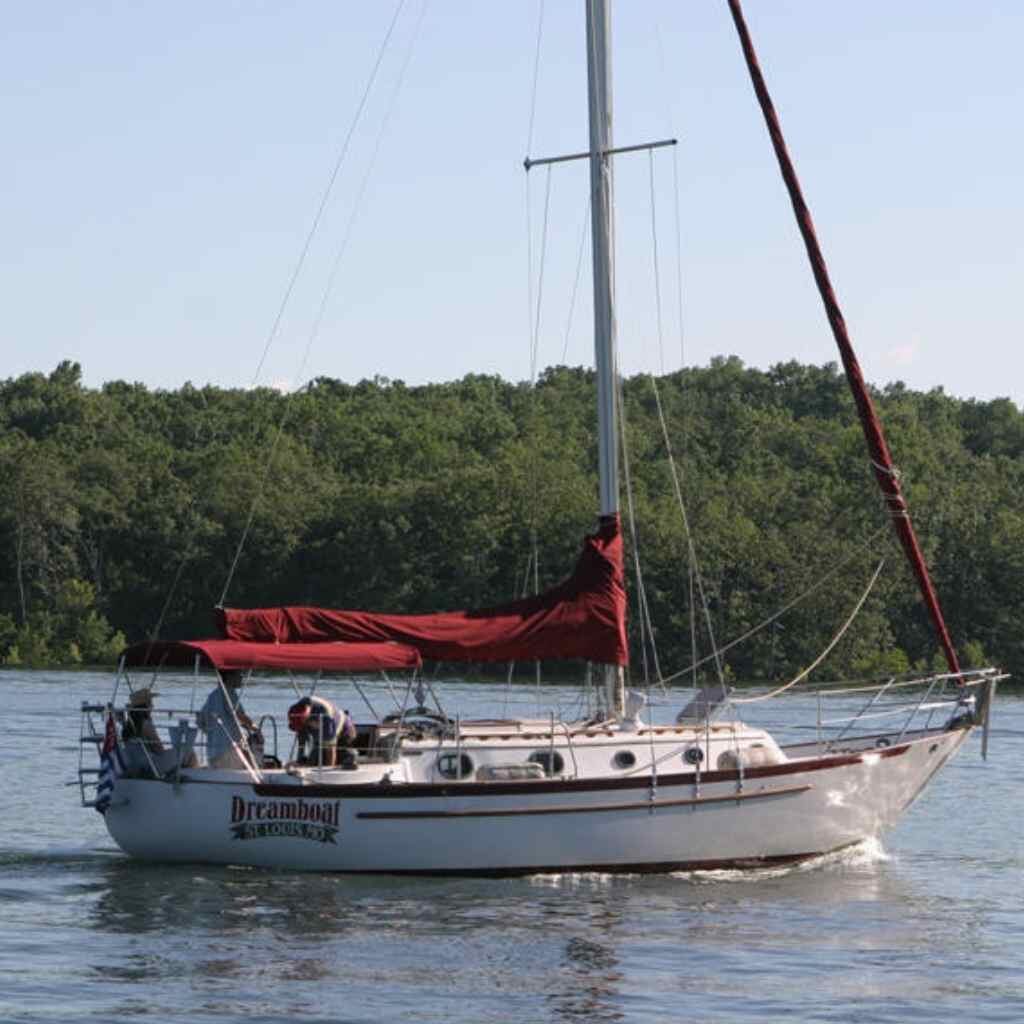
Pacific Seacraft 34 is a smaller heavy displacement semi-long keel sailboat based on the highly successful Crealock 37. It has the same graceful lines and appearance as the Crealock and is known as the Voyagemaker.
It is built with comfort and safety in mind with its large overhanging bow and beautiful sheer line ending with a traditional canoe stern. Constructed with the highest standard, it is a seaworthy sailboat that is ideal for bluewater voyages.
It is a cutter-rigged sailboat with skeg-hung rudders and control lines being fed back to its cockpit. The smaller cockpit may feel cramped but its design lowers the risk of flooding.
Still, it has a great interior suited for living aboard. It has a large headroom, comfortable galley, and up to five berths for comfortable cruising.
Although you may feel some hobby-horsing windward because of the overhangs, Seacraft 34 is overall a very balanced boat with great upwind performance. It has outstanding control capabilities and is able to sustain surfing speed with ease.

This is a double-ended full keel cruiser designed by Bob Perry and built-in Taiwan in response to the rising popularity of Westsail 32. It was offered to the market as a semi-custom boat and built with high-quality materials.
You can modify the internal layout and can choose a ketch, cutter, or pilothouse version. There is an option to use wood or aluminum spars. The mast could also be keel-stepped or deck-stepped.
Before, only 20 were ketch sailboats due to the popularity of the cutter design at that time. Now, ketch has proven to be faster and more balanced between the two.
Tayana is relatively faster than any sailboat in its class. Its best point of sail is in its broad reach. It also tracks well windward, and is an ideal choice for the trades. It is also great how the cockpit is secured from any flooding even when traveling.
Today, a lot of people are still actively sailing this. Tayana 37 has become well known for offshore and blue water sailing.

Canadian Seacraft is well known for its fiberglass racer and cruiser. CS 36 is a small traditional fin keel sailboat with a masthead sloop intended for recreational use. It is seaworthy and has good performance in different weather conditions.
It was designed by Raymond Wall and had a production run between 1978 to 1987. It remains to be popular in both north and south borders.
It is a beautiful sailboat with a graceful sheer line and balanced overhangs at both bow and stern. Its details and quality in design and production are clearly of a higher tier.
It is mostly built with fiberglass and balsa wood. It is equipped with an internally mounted spade transom hung rudder. All of its lines lead to the cockpit, which is ideal for single-handed sailing.
CS 36 Traditional also has a deep-depth draft and wide beams with great access to the cockpit and foredecks. It is wide and spacious, which is perfect for comfortable cruising.
The sailboat has great proportion and traditional aesthetics. It is simple and straightforward, which makes it ideal for bluewater sailing.

This is a sturdy and high-quality sailboat built between 1978 to 1991. It features a progressive design, combining a walk through with the aft-cabin from the main saloon. It is made with a tall and standard rig each supported on double and single spreaders, respectively.
Hallberg Rassy 352 has a nicely balanced hull sporting a fin keel with rudder on skeg, a generous beam, and a 45 percent high ballast ratio. Its water and fuel tanks are placed low in the keel to improve sail carrying ability.
Its production spanning 14 years allowed for continuous improvements in its specifications. Newer sailboats have raised hulls for bigger headroom in the under the deck, aft cabins, and the walkthrough. Engines were also replaced by a Volvo and later a Penta Turbo or the bigger MD 22.
It is impressive how they balanced good interior and sailing performance. It has great seakeeping ability and smooth motion in heavy seas, easily an ideal sailboat for singlehanded sailing.

Corbin 39 was designed based on a Dufour design named Harmonie, increasing freeboard, and flushing the deck. Its style is influenced by the classic Scandinavian cruiser, Westsail 32.
It has a long fin keel, blunt bow, and a high freeboard. It was sold as kits, and various deck molds were produced. They have pilot, aft, and center cockpit variations.
It was made of sturdy and high-quality materials. The earlier version’s decks were of marine grade mahogany but it was later changed with Airex foam. Its lead ballast was encapsulated with fiberglass for added protection.
Earlier boats had a single spreader main or a turbocharged double spreader. Later, Corbin used 49 feet double spreader rigs instead, and all were deck-stepped.
Corbin 39 is truly a strong and seaworthy vessel. With its fin keel and skeg rudder, cutter rig, and reefed main combinations, it could take anyone safely and comfortably anywhere in the world.

Valiant 40 took its looks from Scandinavian double-ender sailboats. It had a successful production run that spanned for 47 years. It proved to be one of the pioneers for modern blue water designs.
Its hull is made from thick hand-laid fiberglass, bolted and covered with teak. Its ballast is cast with lead bolted to the keel stub. Lastly, the skeg is constructed separately from hull molding and encased with fiberglass before being fastened to the hull.
It has a beautiful bow and sheer lines and a longer LWL for maximum speed. At the back are a non-spacious cockpit and a canoe stern ideal for bluewater sailing operations.
Under the waterline is a fin keel with its skeg hung rudder. It perfectly matches with the cruising hall above, minimizing wetted surface area
Overall, Valiant 40 is a seaworthy vessel with great blue water performance. Extremely balanced and well-mannered, it can withstand extreme weather conditions with ease and minimal effort on your part.
It soon gained a reputation as a fast water passage-maker with high integrity. Now, it is regularly used for circumnavigations by solo sailors and voyagers.

If you like a sailboat with a proven track record, then Contessa 32 is for you. It is a seaworthy racer-cruiser with good all-around sailing capabilities released in 1971.
Like its younger sister, Contessa 26, it has great speed, integrity, and affordability . Contessa 32 is a definite combination of old and new with its traditional narrow beam, a full hull with a fin keel, and fiberglass rudder protected by a skeg found in more modern yachts.
It has marked overhangs and a narrow tuck-up stern. It has less headroom below in return for its lesser wind resistance.
This configuration delivers fast racing speed and great stability. It could definitely withstand extreme weather and rough waves. Contessa 32 is claimed to be able to right itself when rolled or capsized.
Contessa 32 is known for its forgiving nature. It has a responsive helm and excellent windward performance. With its astounding stability, it can carry full sail for up to 25 knots.

Fast Passage 39 was designed by William Garden and is said to be a legendary cruiser with speed, ruggedness, and fame. It is a stout double-ender comparable to the Valiant 40.
It has the same LOA and LWL as Valiant and also has nearly identical ballast and displacement. The difference is its narrower frame and more evolved underwater shapes resulting in flatter forward and aft keel sections and less wetted area. It also has great directional stability as its rudder allows great control under wind vane and down steep waves.
It is a high performing sailboat but also difficult to find as only 41 were produced. A part of the group was offered as hull and deck kits intended to be finished by the sailboat owners.
Fast Passage 39 also has a proven track record and has won single-handed blue water races. It performs great under a wide range of conditions, especially in light winds.
By now you should have some idea what makes a vessel Bluewater friendly. There are hundreds of vessels that can make long distance voyage safe and enjoyable. These examples above are just a few examples of the Best Single Handed BlueWater Sailboats.
Leave a Comment Cancel Reply
Your email address will not be published. Required fields are marked *
Save my name, email, and website in this browser for the next time I comment.
Get your "Sailing and Boating" Free Guide
Buying a Sailboat: Sloop vs. Ketch
Consider many different questions when deciding what kind of sailboat is best for you. If you are looking for a cruising sailboat, depending on your preferred size range, you may be choosing between a sloop and a ketch. These are the two most common types of cruising sailboats . Each offers certain advantages.
massmatt/Flickr/CC BY 2.0
A sloop is generally the most common type of sailboat rig. A sloop has a single mast and usually only two sails: the mainsail and a headsail, such as a jib or a genoa. A sloop may also use a racing or cruising spinnaker.
Sloops come in all sizes, from 8-foot dinghies to maxi boats over a hundred feet long. A sloop uses what is called a Bermuda or Marconi rig. This is the tall, thin, triangular mainsail that's commonly seen on the waters of popular boating areas.
The sloop rig generally is simpler to use and cheaper to build than a ketch rig. Because of the wind and sail dynamics involved, a sloop is almost always faster than other rigs in boats of comparable size, especially when sailing windward.
Jukka/Flickr/CC BY 2.0
A ketch is a common rig for cruising sailboats. It has two masts: a traditional mainmast as on a sloop, plus a smaller mast in the rear of the boat. This is called the mizzenmast. Technically, the mizzenmast must be mounted forward of the boat’s rudderpost to be a ketch. If the mizzen is mounted further aft, behind the rudder post, it is considered a yawl. The mizzenmast is typically smaller on a yawl than on a ketch, but otherwise, these rigs are similar.
A ketch, therefore, uses three primary sails: the mainsail and headsail, as on a sloop, plus the mizzen sail aft. A ketch may also use a spinnaker.
The three sails do not necessarily mean that the sail area on a ketch is larger than on a sloop of the same size, however. Sail area is usually planned by boat designers based on the boat's size, displacement (weight), hull shape and configuration, not on the number of masts or sails. This means that the mainsail and headsail of a ketch are generally smaller than on a sloop, but the mizzen sail roughly makes up the difference.
Benefits and Disadvantages of Sloops vs. Ketches
Gellinger/Pixabay/CC0 Creative Commons
Sloops and ketches each have their own benefits, but also disadvantages. When deciding what type of boat to buy, consider these differences.
Advantages of a Sloop
- A sloop is generally faster and sails closer to the wind.
- Sloops have fewer sails than ketches to buy and maintain.
- With a sloop, there is less standing and running rigging with one mast, which means there is less to manage and maintain overall.
- As the most popular contemporary boat, sloops are available in a wide variety.
Disadvantages of a Sloop
- Sloop sails are generally larger and heavier, requiring more strength for handling, hoisting, and trimming, particularly on a larger boat.
- Sloops have fewer options to reduce sail area in stronger winds. Sloops offer only reefing or furling of the sails.
Advantages of a Ketch
- Ketches have smaller sails. These sails are more easily managed and hoisted on a larger boat, which is why ketches are preferred by many older sailors.
- Using only two sails at a time provides multiple options for managing different sailing conditions, such as strong winds.
Disadvantages of a Ketch
- Ketch rigs generally do not sail as fast or as close to the wind as a sloop sailboat.
- Ketches have more standing rigging (shrouds and stays) and running rigging (halyards and sheets) to manage and maintain.
- The mizzenmast in ketches takes up space in the stern.
- There are fewer ketches available on the market. Ketches are more popular as an older boat.
Most ketches are intended as cruising boats that are easy to handle and comfortable for cruising. Many sloops, even sketch sloops, are designed for greater speed and racing. Many ketches, therefore, are different from sloops in ways other than just the masts and sails. Designed as cruisers, many ketches are heavier, more stable in sea conditions, and more commodious down below. On the other hand, contemporary builders produce few ketches, so there are a greater variety of sloops available as new boats.
As in other decisions when shopping for a sailboat, the preferable rig depends mostly on your preferred uses of the boat. The same is true when comparing fixed keel and centerboard sailboats.
The Various Types of Sailboats and Rigs
The 10 Best Places to Buy Bikes of 2024
Learn the Parts of a Sailboat and How to Communicate Them
Owner's Review of the MacGregor 26 Sailboat Models
How to Rig Your Small Sailboat and Prepare to Sail
The 9 Best Beach Cruiser Bikes of 2024
The 10 Best Inflatable Stand-Up Paddleboards of 2024, Tested and Reviewed
Review of the O'Day Mariner 19 Sailboat
The 7 Best Women’s Golf Club Sets of 2024
The 8 Best Beach Wagons of 2024, Tested and Reviewed
The 8 Best Luggage Sets of 2024, Tested and Reviewed
West Wight Potter 19 Sailboat Review
The 6 Best Marine Batteries of 2024
The 7 Best Ice Augers of 2023
The 9 Best Slip-On Sneakers for Men of 2024, Tested and Reviewed
How to Charter a Private Yacht
- BOAT OF THE YEAR
- Newsletters
- Sailboat Reviews
- Boating Safety
- Sails and Rigging
- Maintenance
- Sailing Totem
- Sailor & Galley
- Living Aboard
- Destinations
- Gear & Electronics
- Charter Resources

- By Daria Blackwell
- Updated: May 4, 2007
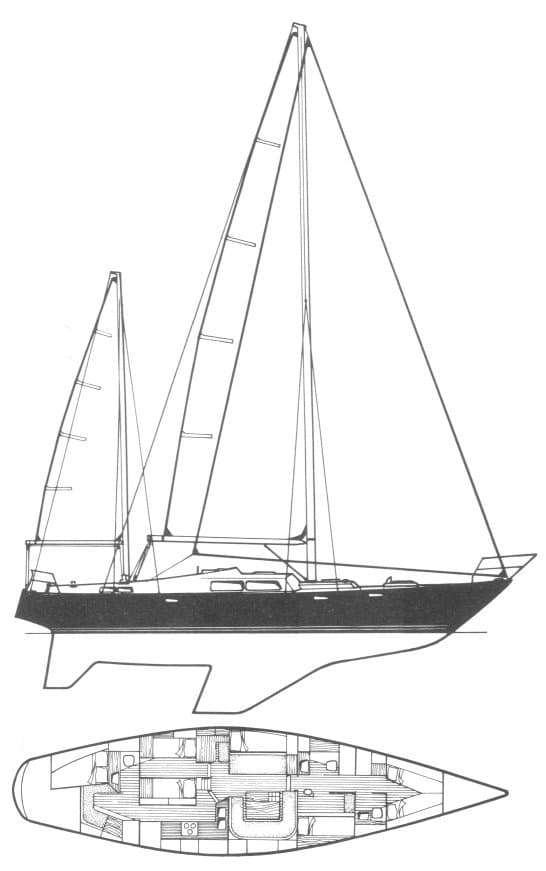
My husband, Alex, and I intended to be cruising the world for some time, with no particular plan to circumnavigate, and we had a pretty reasonable set of criteria for the vessel that would help us get there. The boat had to be sturdy, capable of handling heavy seas and possible collisions with floating objects, and manageable for each of us alone. It had to be comfortable under way and at anchor, and it had to be pretty. We expected to sail doublehanded for the most part, so we wanted a split rig.
At the end of a long search, the boat that sang to us was a Bowman 57 ketch, which was designed by Holman & Pye, who later designed many Oysters, and built in 1976 by Bowman Yachts, located in Southampton, England. We named her Aleria.
She’s a “boat-shaped boat” with beautiful lines, a delicate transom, and a wave-splitting bow. Drawing more than 8 feet, she’s not about to go gunkholing, but she’ll certainly handle a sea well. Her skeg-hung rudder is protected behind a substantial fin keel onto which the mast is stepped. The hull is solid fiberglass-no balsa core to rot, no foam core to get soggy or crack. If she hits something solid, she’s likely to bounce.
With a beam of less than 15 feet, the Bowman 57 is svelte by current standards, and the design’s slenderness makes a difference belowdecks. It’s possible to traverse her length with handholds all the way.
As was usual with boats of this size and vintage, Bowman 57s were customized for individual owners. Aleria, formerly Grand Dame, had been originally commissioned by the pianist Andre Watts. The galley has custom-designed tile work, Corian countertops, double stainless-steel full-size sinks, a three-burner stove, cabinets galore, and double refrigeration compartments. In this long galley, on the starboard side under the cockpit, bracing yourself is easy: Cabinetry and bulkheads bind its entire length.
The navigation station, to port at the foot of the companionway, has a nicely sized chart table. Adjacent to it is an office, with full-size drawers for paper charts, a desk for a computer, an office chair, cabinets, and more. The aft cabin has a single berth to starboard and a double to port with cushions between, both good sea berths. It doesn’t have enough storage space, but it could be easily modified. An adjoining head has a shower, a full-size toilet, and a porcelain sink.
The well-ventilated saloon seats six around the table using only the U-shaped settee, eight with chairs added at the end, and three more on the port settee. Forward are two cabins with two bunk berths each and another head and shower. In the forepeak is a workshop complete with workbench, vise, and cabinets.
Ketch rigged and with double headsails, the 57 can take on sail in small enough doses for each of us to be able to handle them. Aleria behaves like the big boat she is, responding more slowly to the helm than what we were used to. My first turn at the wheel was intimidating, but I took comfort in the feeling from the center cockpit that following seas were a long way “back there.” Once under way, balanced and in the groove, she sails like a freight train.
Only a handful of Bowman 57s were built. All have differences in layout; prices range from $250,000 to $350,000.
Bowman 57 Specs
LOA: 57′ 0″ (17.37 m.) LWL: 44′ 7″ (13.59 m.) Beam: 14′ 8″ (4.47 m.) Draft: 8′ 4″ (2.54 m.) Sail Area (100%): 1,162 sq. ft. (107.9 sq. m.) Ballast:16,000 lb. (7,258 kg.) Displacement: 42,000 lb. (19,051 kg.) Ballast/D: .38 D/L: 212 SA/D: 15.4 Water: 350 gal. (1,327 l.) Fuel: 200 gal. (758 l.) Engine: Various Designer: Holman & Pye
Lifelong sailors Daria Blackwell and her husband, Alex, operate CoastalBoating.net on Long Island, New York.
- More: 2001 - 2010 , 50+ ft , Bluewater Cruising , bowman , keelboat , monohull , Sailboat Reviews , Sailboats
- More Sailboats

For Sale: 2015 Catalina 355

For Sale: 1998 Hinckley 51

Sailboat Review: HH Catamarans HH44

Sailboat Preview: 2 Sportboats We Love

A Dream Takes Flight
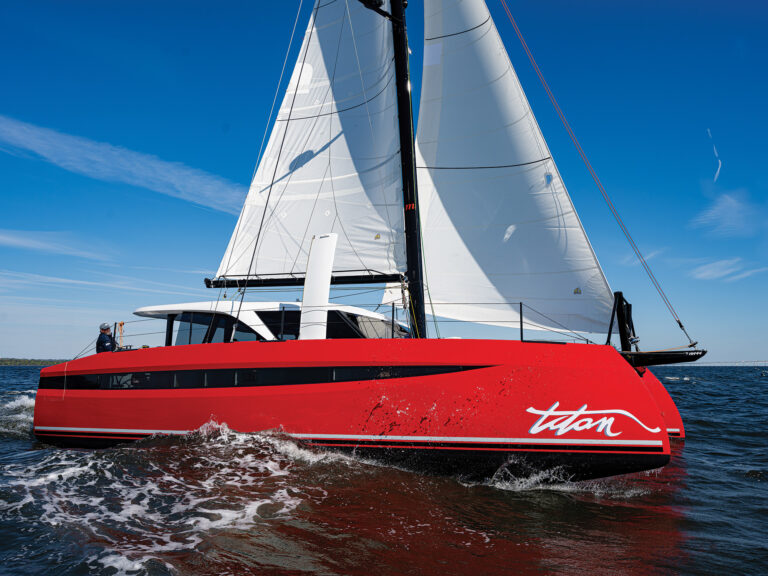
- Digital Edition
- Customer Service
- Privacy Policy
- Email Newsletters
- Cruising World
- Sailing World
- Salt Water Sportsman
- Sport Fishing
- Wakeboarding
Visit our Popular Forums
- Monohull Sailboats
- Multihull Sailboats
- Powered Boats
- General Sailing
- Antares Yachts
- Fountaine Pajot
- Lagoon Catamarans
Cruising Business
- Boat Classifieds
- General Classifieds
- Crew Positions
- Commercial Posts
- Vendor Spotlight
Life Aboard a Boat
- Provisioning: Food & Drink
- Families, Kids, & Pets Afloat
- Recreation, Entertainment, & Fun
- Boat Ownership & Making a Living
- Liveaboard's Forum
Seamanship, Navigation & Boat Handling
- Seamanship & Boat Handling
- Training, Licensing, & Certification
- Health, Safety, & Related Gear
- Rules of the Road, Regulations, & Red Tape
Engineering & Systems
- Const. / Maint. / Refit
- Product / Service Reviews
- Electronics: Comms / AV
- Electrical: Batts / Gen / Solar
- Lithium Power Systems
- Engines & Propulsion
- Propellers & Drive Systems
- Plumbing / Fixtures
- Deck Hdw: Rigging / Sails
- Aux. Equipment & Dinghy
- Anchoring & Mooring
Photo Categories
- Member Galleries
- Life Onboard
- Sailing in the Wind
- Power Boats
- Cruising Destinations
- Maint. & Boat Building
- Marine Life
- Scuba Diving & Divers
- General Photos
Recent Photos

Listing Categories
- African Cats
- view more »
- Crew Wanted
- Crew Available
- Enhance Your Account
- Meet the Mods
- Meet the Advisors
- Signup for The Daily Cruiser Email

| |||||||||||||||||||||||||||||||||||||||||||||||||||||||||||||||||||||||||||||||||||||||||||||||||||||||||||||||||||||||||||||||||||||||||||||||||||||||||||||||||||||||||||||||||




IMAGES
VIDEO
COMMENTS
Swan 65. This is perhaps the most famed ketch rigged yacht of all time, a Sparkmans and Stephens design from an era when a state-of-the-art racing boat would also make a superbly comfortable cruising yacht. The model shot to fame in the first Whitbread Round the World Race (now the Volvo Ocean Race) in 1973/4.
Ketch sailing vessels for sale on YachtWorld are offered at a variety of prices from $12,640 on the relatively lower-priced, classic models all the way up to $12,088,300 for the more lavish boat models. Find Ketch boats for sale in your area & across the world on YachtWorld. Offering the best selection of boats to choose from.
A ketch has two masts: a traditional mainmast, just like a sloop, and a second mast at the rear of the boat, called a mizzen mast. For it to be a ketch, the mizzen is mounted forward of the rudder-post. If it's mounted behind, it's called a yawl. SAILS. The main sails used on a ketch are the headsail, the mainsail and the mizzen sail, so ...
Best bluewater sailboats for comfort Amel 55 This is the successor to the legendary Super Maramu, a ketch design that for several decades defined easy downwind handling and fostered a cult ...
The 10 best bluewater boats. 1. Westsail 32. Photo credit: SailboatData.com. The Westsail 32 is one of the most iconic bluewater cruisers and 19 have set out to cross the Pacific in the PPJ rally since 2009. In 1973, this small cruising sailboat garnered a 4-page spread in Time magazine.
This 53-footer is idiosyncratically French, and it's also a superbly focused bluewater cruiser. Designed to be handled by a couple, its ketch rig is docile yet effective, with sails set on electric furling gears and some ingenious sail handling systems. Nearly 500 of these boats were built before Amel replaced it with the 54.
The Ketch. What's in a Rig Series #4. Ketch rigs hold a special place in many a cruising sailor's heart. There's something dignified and majestic about them. They are two masted rigs with a main mast and a (smaller) mizzenmast - they carry a jib just like a sloop. Generally, ketches will be in the 40-plus foot range.
This design allows for a versatile sail plan, with various combinations of sails that provide excellent balance and handling. The purpose of ketch sailboats is to offer enhanced control, stability, and ease of handling, making them suitable for both coastal cruising and long-distance passages. Courtesy of Yacht World.
Halsey Herreshoff is unclear about dates or specifics, but he confirms what printed sail plans show, that the total working sail area of his H-31 grew from an original 403 sq. ft. to a subsequent 466 sq. ft. At the same time, the displacement shrunk from 8,640 pounds to 7,560 pounds.
So, in answer to the original question, although they're not the best choice for windward sailing, the ketch can make an ideal cruising sailboat. Lastly, the mizzen mast on a ketch sailboat provides an ideal place to mount your radar scanner and wind generator. And as one old sea-dog once told me, a convenient thing to lean against when you're ...
Impress your sloop-sailing friends with fancy ketch tricks. Sail backward through the mooring field (spin circles if you have a sharpie), nose casually up to anchor, hove-to with jig and jigger. Barrel westward on a reach. Turbo-charge off-wind sailing by setting a mizzen staysail. Don't fear a dismasting.
The ketch rig is an especially effective rig for larger boats (40ft and up). Just a quick recap: the ketch is a two-masted sailboat that has a mainmast (front) and shorter mizzenmast (aft or back). Both masts carry a mainsail. The sail on the mizzenmast is also called the jigger. Your mizzensail provides all kinds of benefits.
A ketch is a two-masted sailboat with a tall mizzenmast mast aft of the mainmast. A key characteristic of Ketch sailboats is that their mizzenmast is shorter than the mainmast. The mainmast itself is typical and resembles a sloop mast. A ketch has a mainsail and one or more headsails on the mainmast, along with a single mizzen on the mizzenmast.
A ketch is a type of sailboat that has two masts, with a smaller mast located at the stern. The smaller mast is known as the mizzenmast, and it is usually smaller than the main mast. Ketch sailing is a popular activity among avid sailors, as it offers a range of benefits, including improved stability, increased speed, and excellent maneuverability.
For a yawl, the mizzen mast is much smaller than the one on a ketch and is located far behind the rudder post. This makes the sail area of the mizzen sail on a yawl smaller as well. The mizzen mast on a yawl balances the sail plan, and the mizzen sail is trimmed for balance. Easing the mizzen sail will make it less effective while over-trimming ...
Before, only 20 were ketch sailboats due to the popularity of the cutter design at that time. Now, ketch has proven to be faster and more balanced between the two. Tayana is relatively faster than any sailboat in its class. Its best point of sail is in its broad reach. It also tracks well windward, and is an ideal choice for the trades.
Advantages of a Sloop. A sloop is generally faster and sails closer to the wind. Sloops have fewer sails than ketches to buy and maintain. With a sloop, there is less standing and running rigging with one mast, which means there is less to manage and maintain overall. As the most popular contemporary boat, sloops are available in a wide variety.
We expected to sail doublehanded for the most part, so we wanted a split rig. At the end of a long search, the boat that sang to us was a Bowman 57 ketch, which was designed by Holman & Pye, who later designed many Oysters, and built in 1976 by Bowman Yachts, located in Southampton, England. We named her Aleria.
Boat: Hermann Lazyjack 32 schooner. Posts: 70. Re: Ketch sailing for beginners. As you suggest, the mizzen tends to push the stern downwind, with the result that the bow is pushed up into the wind. Try easing the mizzen. The "balance" you are looking for is to balance the tendency of the jib/genoa to push the bow off the wind, with the mizzen ...
Forty years ago, it was widely believed that a full keel ketch was the only way to sail around the world. Then someone raced across the Southern Ocean in a trimaran. ... Purchasing or building a new boat does allow you to customize the vessel to suit your tastes and best serve your needs. Cabins can be moved, saloon layouts modified, and deck ...
The Celestial 48 is a ketch rig with a shoal-draft, fin-keel design, and a center-cockpit configuration that is comfortable and ideal for bluewater sailing. One of our favorite features is the six-foot, two-inch headroom in the cabin, along with high-capacity water and fuel tanks. ... The best advice for buying a boat is to be truly honest with ...
Find Ketch boats for sale in North America. Offering the best selection of boats to choose from.
Mizzens on yawls also tend be rather short. On a ketch the mizzen is forward of the rudder and is usually significantly taller. In a classic schooner rig, the taller mainmast is aft and the shorter foremast is forward. On some schooners, however, the masts may be the same height. For many years it was axiomatic that a split rig must be best for ...